Strategic Global Finance: Cafe de Coral's Financial Decisions
VerifiedAdded on 2023/06/15
|17
|5849
|409
Report
AI Summary
This report provides an analysis of strategic and global finance concepts, using Cafe de Coral as a case study. It defines globalization, investment processes, and their interrelation, examining the advantages of investment in a globalized world. The report identifies and evaluates various global business environment factors influencing organizations, assessing their impact on national and multinational entities. It computes Cafe de Coral's current value statement, evaluates strategies for enhancing organizational value, and recommends strategies for improvement. Furthermore, the report analyzes strategic decisions made by Cafe de Coral and their financial consequences. It also describes different financial sources, analyzes associated risks and costs, discusses global risks faced by the company, and explains investment strategies adopted in the global environment. This document is available on Desklib, a platform offering a wide range of study resources for students.
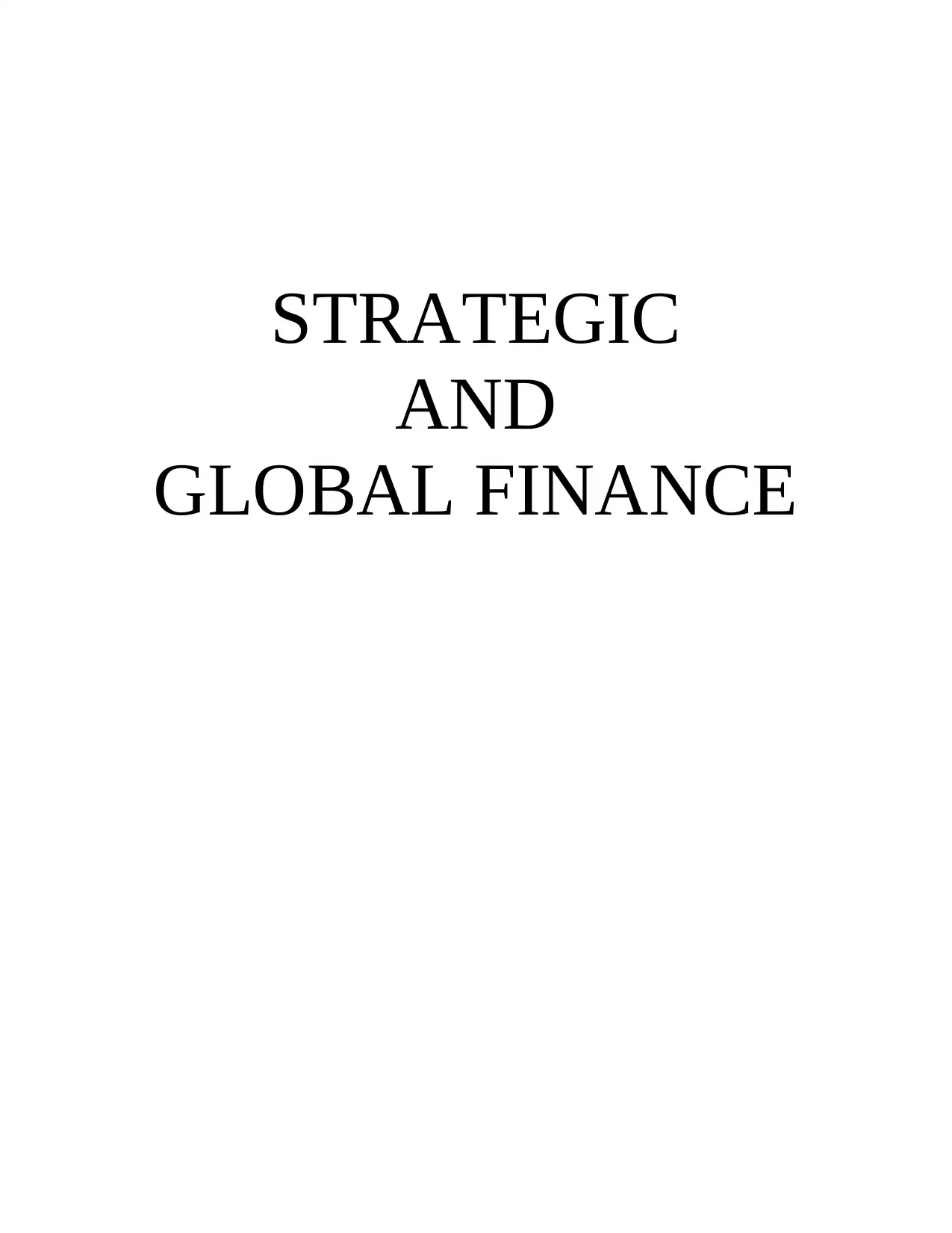
STRATEGIC
AND
GLOBAL FINANCE
AND
GLOBAL FINANCE
Secure Best Marks with AI Grader
Need help grading? Try our AI Grader for instant feedback on your assignments.
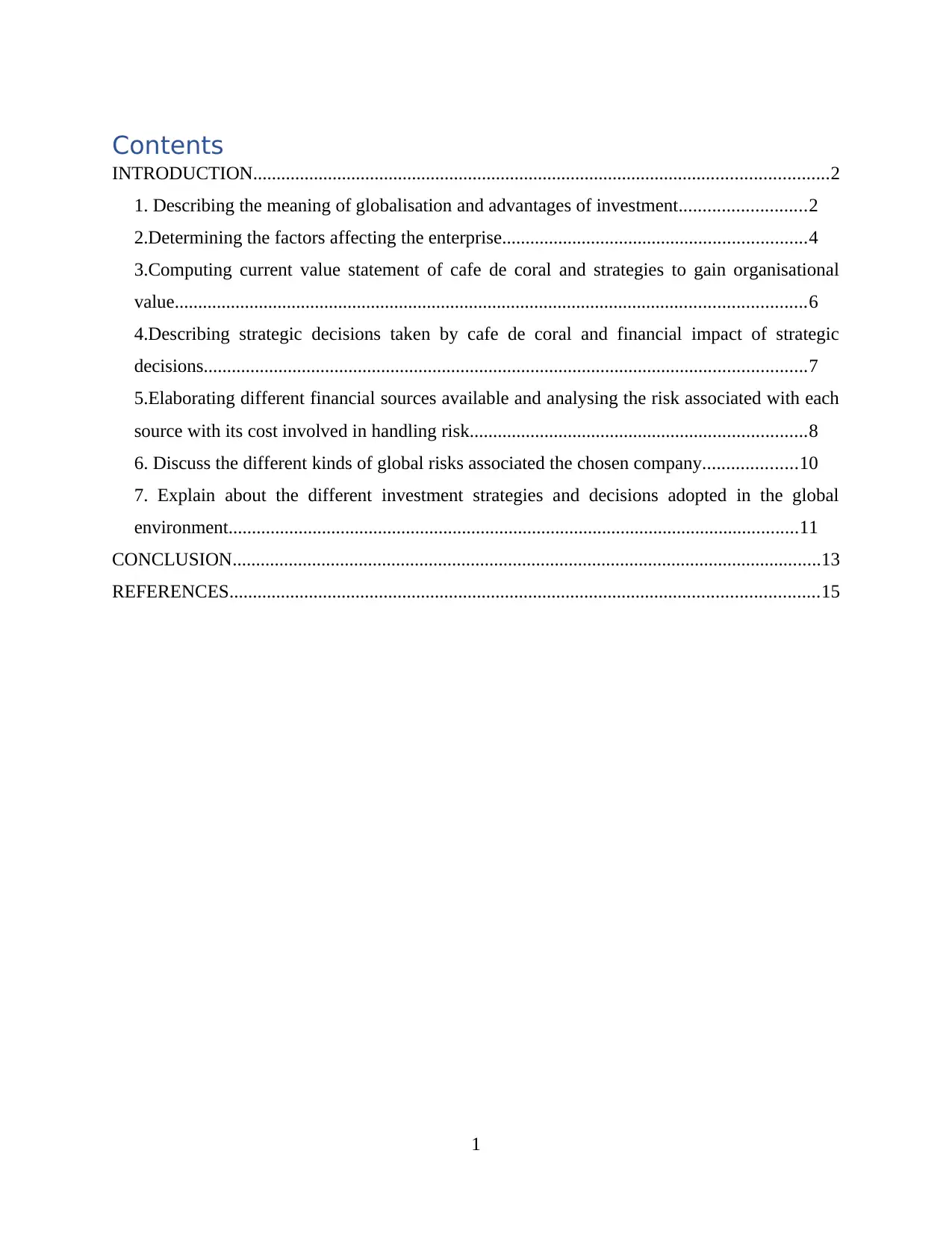
Contents
INTRODUCTION...........................................................................................................................2
1. Describing the meaning of globalisation and advantages of investment...........................2
2.Determining the factors affecting the enterprise.................................................................4
3.Computing current value statement of cafe de coral and strategies to gain organisational
value.......................................................................................................................................6
4.Describing strategic decisions taken by cafe de coral and financial impact of strategic
decisions.................................................................................................................................7
5.Elaborating different financial sources available and analysing the risk associated with each
source with its cost involved in handling risk........................................................................8
6. Discuss the different kinds of global risks associated the chosen company....................10
7. Explain about the different investment strategies and decisions adopted in the global
environment..........................................................................................................................11
CONCLUSION..............................................................................................................................13
REFERENCES..............................................................................................................................15
1
INTRODUCTION...........................................................................................................................2
1. Describing the meaning of globalisation and advantages of investment...........................2
2.Determining the factors affecting the enterprise.................................................................4
3.Computing current value statement of cafe de coral and strategies to gain organisational
value.......................................................................................................................................6
4.Describing strategic decisions taken by cafe de coral and financial impact of strategic
decisions.................................................................................................................................7
5.Elaborating different financial sources available and analysing the risk associated with each
source with its cost involved in handling risk........................................................................8
6. Discuss the different kinds of global risks associated the chosen company....................10
7. Explain about the different investment strategies and decisions adopted in the global
environment..........................................................................................................................11
CONCLUSION..............................................................................................................................13
REFERENCES..............................................................................................................................15
1
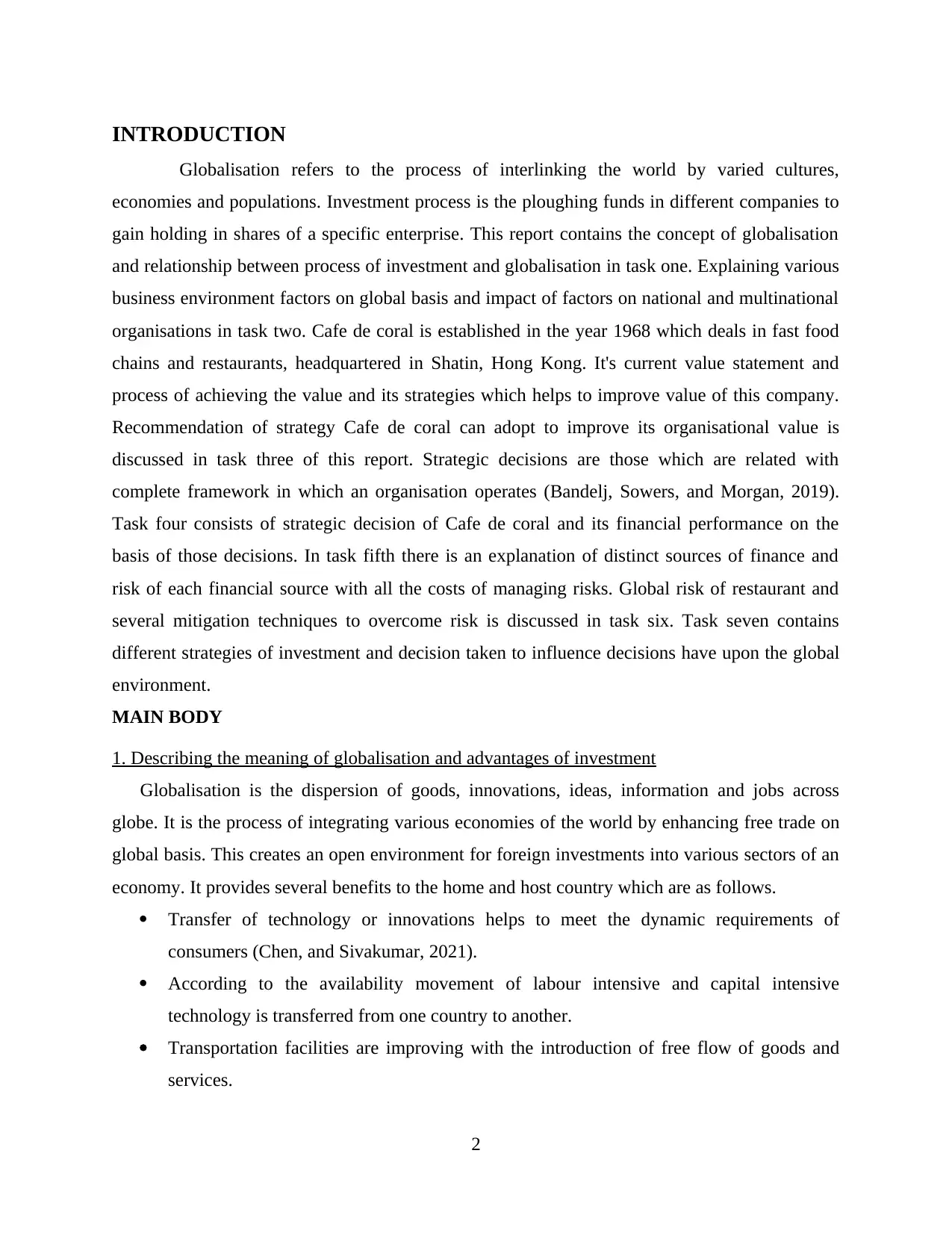
INTRODUCTION
Globalisation refers to the process of interlinking the world by varied cultures,
economies and populations. Investment process is the ploughing funds in different companies to
gain holding in shares of a specific enterprise. This report contains the concept of globalisation
and relationship between process of investment and globalisation in task one. Explaining various
business environment factors on global basis and impact of factors on national and multinational
organisations in task two. Cafe de coral is established in the year 1968 which deals in fast food
chains and restaurants, headquartered in Shatin, Hong Kong. It's current value statement and
process of achieving the value and its strategies which helps to improve value of this company.
Recommendation of strategy Cafe de coral can adopt to improve its organisational value is
discussed in task three of this report. Strategic decisions are those which are related with
complete framework in which an organisation operates (Bandelj, Sowers, and Morgan, 2019).
Task four consists of strategic decision of Cafe de coral and its financial performance on the
basis of those decisions. In task fifth there is an explanation of distinct sources of finance and
risk of each financial source with all the costs of managing risks. Global risk of restaurant and
several mitigation techniques to overcome risk is discussed in task six. Task seven contains
different strategies of investment and decision taken to influence decisions have upon the global
environment.
MAIN BODY
1. Describing the meaning of globalisation and advantages of investment
Globalisation is the dispersion of goods, innovations, ideas, information and jobs across
globe. It is the process of integrating various economies of the world by enhancing free trade on
global basis. This creates an open environment for foreign investments into various sectors of an
economy. It provides several benefits to the home and host country which are as follows.
Transfer of technology or innovations helps to meet the dynamic requirements of
consumers (Chen, and Sivakumar, 2021).
According to the availability movement of labour intensive and capital intensive
technology is transferred from one country to another.
Transportation facilities are improving with the introduction of free flow of goods and
services.
2
Globalisation refers to the process of interlinking the world by varied cultures,
economies and populations. Investment process is the ploughing funds in different companies to
gain holding in shares of a specific enterprise. This report contains the concept of globalisation
and relationship between process of investment and globalisation in task one. Explaining various
business environment factors on global basis and impact of factors on national and multinational
organisations in task two. Cafe de coral is established in the year 1968 which deals in fast food
chains and restaurants, headquartered in Shatin, Hong Kong. It's current value statement and
process of achieving the value and its strategies which helps to improve value of this company.
Recommendation of strategy Cafe de coral can adopt to improve its organisational value is
discussed in task three of this report. Strategic decisions are those which are related with
complete framework in which an organisation operates (Bandelj, Sowers, and Morgan, 2019).
Task four consists of strategic decision of Cafe de coral and its financial performance on the
basis of those decisions. In task fifth there is an explanation of distinct sources of finance and
risk of each financial source with all the costs of managing risks. Global risk of restaurant and
several mitigation techniques to overcome risk is discussed in task six. Task seven contains
different strategies of investment and decision taken to influence decisions have upon the global
environment.
MAIN BODY
1. Describing the meaning of globalisation and advantages of investment
Globalisation is the dispersion of goods, innovations, ideas, information and jobs across
globe. It is the process of integrating various economies of the world by enhancing free trade on
global basis. This creates an open environment for foreign investments into various sectors of an
economy. It provides several benefits to the home and host country which are as follows.
Transfer of technology or innovations helps to meet the dynamic requirements of
consumers (Chen, and Sivakumar, 2021).
According to the availability movement of labour intensive and capital intensive
technology is transferred from one country to another.
Transportation facilities are improving with the introduction of free flow of goods and
services.
2
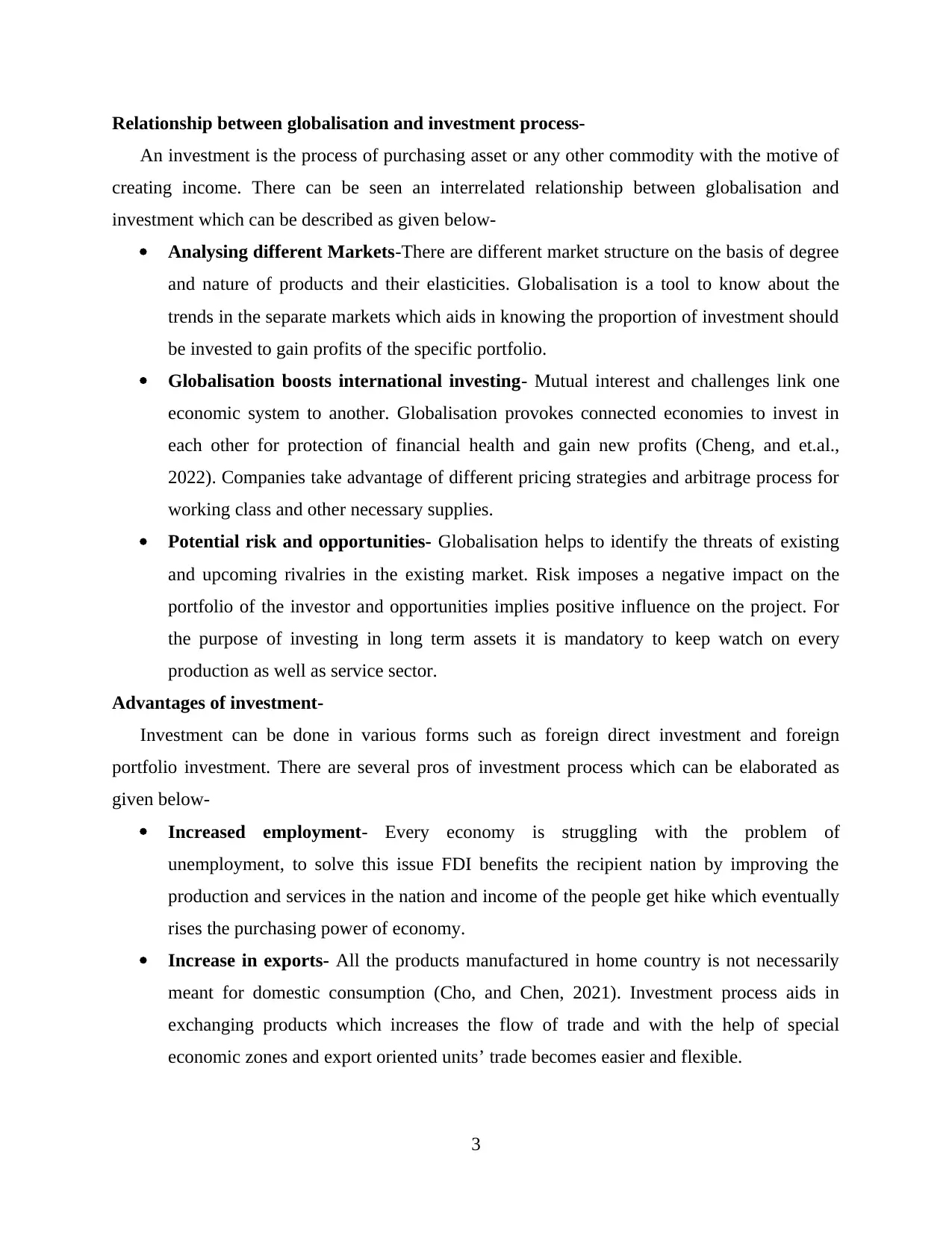
Relationship between globalisation and investment process-
An investment is the process of purchasing asset or any other commodity with the motive of
creating income. There can be seen an interrelated relationship between globalisation and
investment which can be described as given below-
Analysing different Markets-There are different market structure on the basis of degree
and nature of products and their elasticities. Globalisation is a tool to know about the
trends in the separate markets which aids in knowing the proportion of investment should
be invested to gain profits of the specific portfolio.
Globalisation boosts international investing- Mutual interest and challenges link one
economic system to another. Globalisation provokes connected economies to invest in
each other for protection of financial health and gain new profits (Cheng, and et.al.,
2022). Companies take advantage of different pricing strategies and arbitrage process for
working class and other necessary supplies.
Potential risk and opportunities- Globalisation helps to identify the threats of existing
and upcoming rivalries in the existing market. Risk imposes a negative impact on the
portfolio of the investor and opportunities implies positive influence on the project. For
the purpose of investing in long term assets it is mandatory to keep watch on every
production as well as service sector.
Advantages of investment-
Investment can be done in various forms such as foreign direct investment and foreign
portfolio investment. There are several pros of investment process which can be elaborated as
given below-
Increased employment- Every economy is struggling with the problem of
unemployment, to solve this issue FDI benefits the recipient nation by improving the
production and services in the nation and income of the people get hike which eventually
rises the purchasing power of economy.
Increase in exports- All the products manufactured in home country is not necessarily
meant for domestic consumption (Cho, and Chen, 2021). Investment process aids in
exchanging products which increases the flow of trade and with the help of special
economic zones and export oriented units’ trade becomes easier and flexible.
3
An investment is the process of purchasing asset or any other commodity with the motive of
creating income. There can be seen an interrelated relationship between globalisation and
investment which can be described as given below-
Analysing different Markets-There are different market structure on the basis of degree
and nature of products and their elasticities. Globalisation is a tool to know about the
trends in the separate markets which aids in knowing the proportion of investment should
be invested to gain profits of the specific portfolio.
Globalisation boosts international investing- Mutual interest and challenges link one
economic system to another. Globalisation provokes connected economies to invest in
each other for protection of financial health and gain new profits (Cheng, and et.al.,
2022). Companies take advantage of different pricing strategies and arbitrage process for
working class and other necessary supplies.
Potential risk and opportunities- Globalisation helps to identify the threats of existing
and upcoming rivalries in the existing market. Risk imposes a negative impact on the
portfolio of the investor and opportunities implies positive influence on the project. For
the purpose of investing in long term assets it is mandatory to keep watch on every
production as well as service sector.
Advantages of investment-
Investment can be done in various forms such as foreign direct investment and foreign
portfolio investment. There are several pros of investment process which can be elaborated as
given below-
Increased employment- Every economy is struggling with the problem of
unemployment, to solve this issue FDI benefits the recipient nation by improving the
production and services in the nation and income of the people get hike which eventually
rises the purchasing power of economy.
Increase in exports- All the products manufactured in home country is not necessarily
meant for domestic consumption (Cho, and Chen, 2021). Investment process aids in
exchanging products which increases the flow of trade and with the help of special
economic zones and export oriented units’ trade becomes easier and flexible.
3
Secure Best Marks with AI Grader
Need help grading? Try our AI Grader for instant feedback on your assignments.
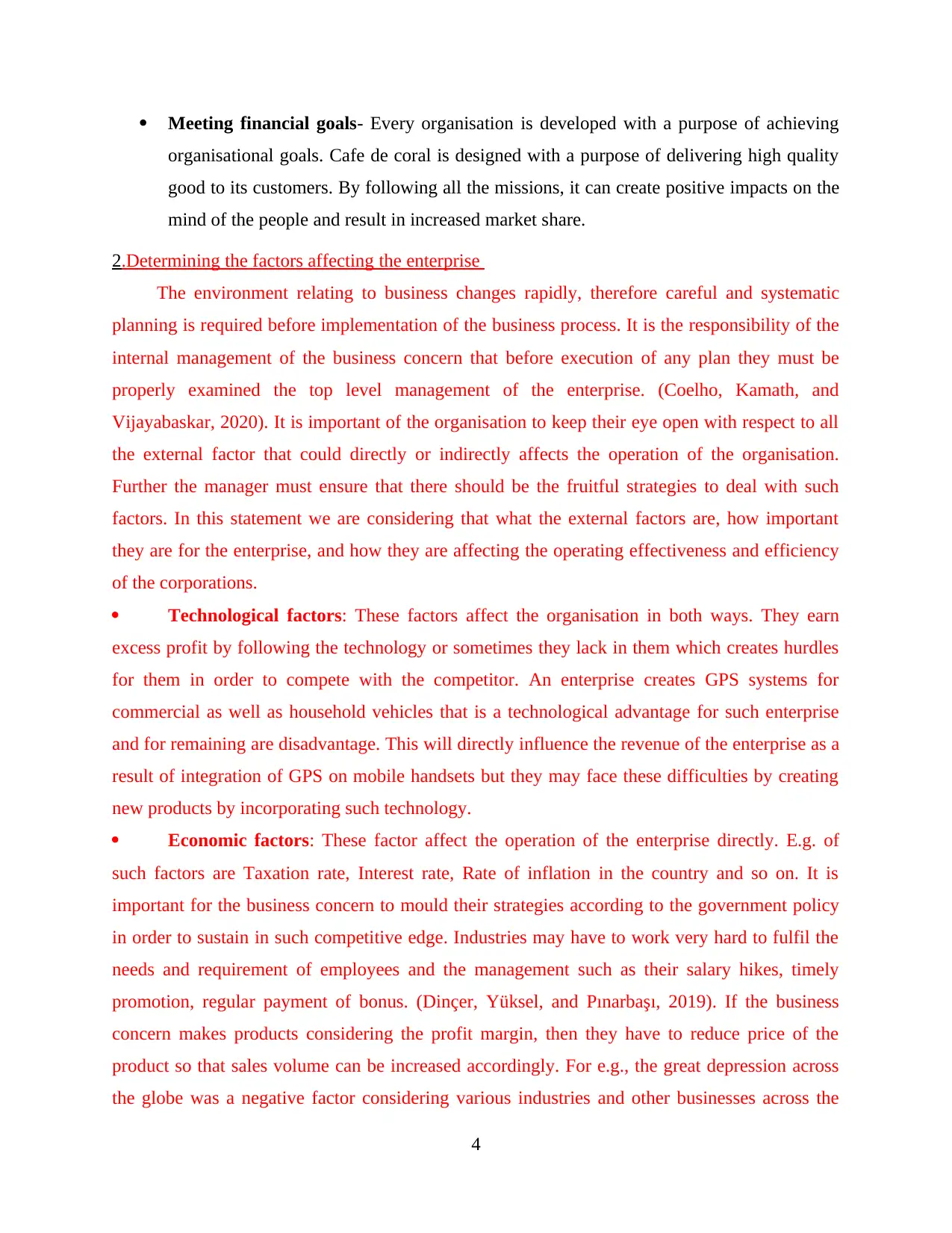
Meeting financial goals- Every organisation is developed with a purpose of achieving
organisational goals. Cafe de coral is designed with a purpose of delivering high quality
good to its customers. By following all the missions, it can create positive impacts on the
mind of the people and result in increased market share.
2.Determining the factors affecting the enterprise
The environment relating to business changes rapidly, therefore careful and systematic
planning is required before implementation of the business process. It is the responsibility of the
internal management of the business concern that before execution of any plan they must be
properly examined the top level management of the enterprise. (Coelho, Kamath, and
Vijayabaskar, 2020). It is important of the organisation to keep their eye open with respect to all
the external factor that could directly or indirectly affects the operation of the organisation.
Further the manager must ensure that there should be the fruitful strategies to deal with such
factors. In this statement we are considering that what the external factors are, how important
they are for the enterprise, and how they are affecting the operating effectiveness and efficiency
of the corporations.
Technological factors: These factors affect the organisation in both ways. They earn
excess profit by following the technology or sometimes they lack in them which creates hurdles
for them in order to compete with the competitor. An enterprise creates GPS systems for
commercial as well as household vehicles that is a technological advantage for such enterprise
and for remaining are disadvantage. This will directly influence the revenue of the enterprise as a
result of integration of GPS on mobile handsets but they may face these difficulties by creating
new products by incorporating such technology.
Economic factors: These factor affect the operation of the enterprise directly. E.g. of
such factors are Taxation rate, Interest rate, Rate of inflation in the country and so on. It is
important for the business concern to mould their strategies according to the government policy
in order to sustain in such competitive edge. Industries may have to work very hard to fulfil the
needs and requirement of employees and the management such as their salary hikes, timely
promotion, regular payment of bonus. (Dinçer, Yüksel, and Pınarbaşı, 2019). If the business
concern makes products considering the profit margin, then they have to reduce price of the
product so that sales volume can be increased accordingly. For e.g., the great depression across
the globe was a negative factor considering various industries and other businesses across the
4
organisational goals. Cafe de coral is designed with a purpose of delivering high quality
good to its customers. By following all the missions, it can create positive impacts on the
mind of the people and result in increased market share.
2.Determining the factors affecting the enterprise
The environment relating to business changes rapidly, therefore careful and systematic
planning is required before implementation of the business process. It is the responsibility of the
internal management of the business concern that before execution of any plan they must be
properly examined the top level management of the enterprise. (Coelho, Kamath, and
Vijayabaskar, 2020). It is important of the organisation to keep their eye open with respect to all
the external factor that could directly or indirectly affects the operation of the organisation.
Further the manager must ensure that there should be the fruitful strategies to deal with such
factors. In this statement we are considering that what the external factors are, how important
they are for the enterprise, and how they are affecting the operating effectiveness and efficiency
of the corporations.
Technological factors: These factors affect the organisation in both ways. They earn
excess profit by following the technology or sometimes they lack in them which creates hurdles
for them in order to compete with the competitor. An enterprise creates GPS systems for
commercial as well as household vehicles that is a technological advantage for such enterprise
and for remaining are disadvantage. This will directly influence the revenue of the enterprise as a
result of integration of GPS on mobile handsets but they may face these difficulties by creating
new products by incorporating such technology.
Economic factors: These factor affect the operation of the enterprise directly. E.g. of
such factors are Taxation rate, Interest rate, Rate of inflation in the country and so on. It is
important for the business concern to mould their strategies according to the government policy
in order to sustain in such competitive edge. Industries may have to work very hard to fulfil the
needs and requirement of employees and the management such as their salary hikes, timely
promotion, regular payment of bonus. (Dinçer, Yüksel, and Pınarbaşı, 2019). If the business
concern makes products considering the profit margin, then they have to reduce price of the
product so that sales volume can be increased accordingly. For e.g., the great depression across
the globe was a negative factor considering various industries and other businesses across the
4
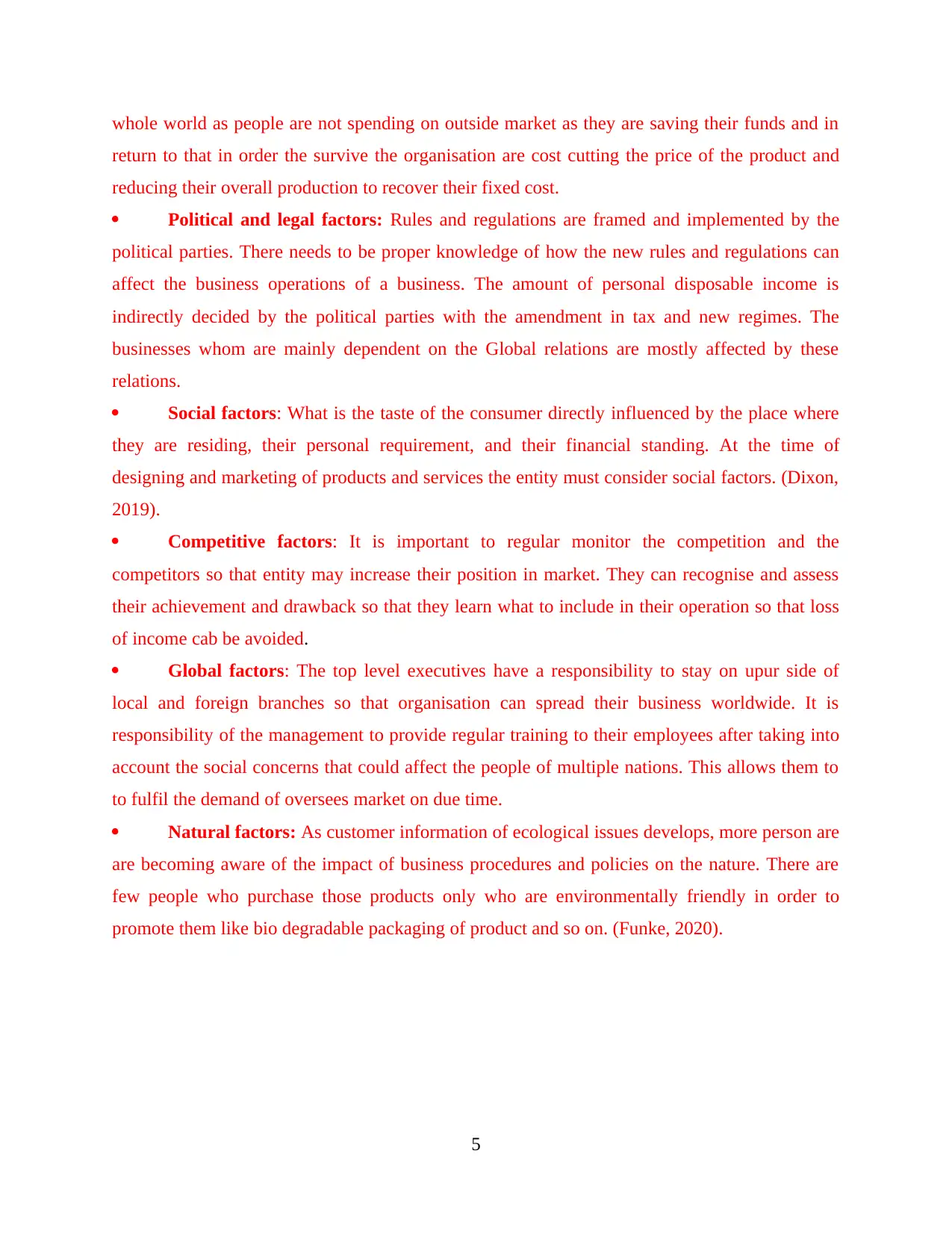
whole world as people are not spending on outside market as they are saving their funds and in
return to that in order the survive the organisation are cost cutting the price of the product and
reducing their overall production to recover their fixed cost.
Political and legal factors: Rules and regulations are framed and implemented by the
political parties. There needs to be proper knowledge of how the new rules and regulations can
affect the business operations of a business. The amount of personal disposable income is
indirectly decided by the political parties with the amendment in tax and new regimes. The
businesses whom are mainly dependent on the Global relations are mostly affected by these
relations.
Social factors: What is the taste of the consumer directly influenced by the place where
they are residing, their personal requirement, and their financial standing. At the time of
designing and marketing of products and services the entity must consider social factors. (Dixon,
2019).
Competitive factors: It is important to regular monitor the competition and the
competitors so that entity may increase their position in market. They can recognise and assess
their achievement and drawback so that they learn what to include in their operation so that loss
of income cab be avoided.
Global factors: The top level executives have a responsibility to stay on upur side of
local and foreign branches so that organisation can spread their business worldwide. It is
responsibility of the management to provide regular training to their employees after taking into
account the social concerns that could affect the people of multiple nations. This allows them to
to fulfil the demand of oversees market on due time.
Natural factors: As customer information of ecological issues develops, more person are
are becoming aware of the impact of business procedures and policies on the nature. There are
few people who purchase those products only who are environmentally friendly in order to
promote them like bio degradable packaging of product and so on. (Funke, 2020).
5
return to that in order the survive the organisation are cost cutting the price of the product and
reducing their overall production to recover their fixed cost.
Political and legal factors: Rules and regulations are framed and implemented by the
political parties. There needs to be proper knowledge of how the new rules and regulations can
affect the business operations of a business. The amount of personal disposable income is
indirectly decided by the political parties with the amendment in tax and new regimes. The
businesses whom are mainly dependent on the Global relations are mostly affected by these
relations.
Social factors: What is the taste of the consumer directly influenced by the place where
they are residing, their personal requirement, and their financial standing. At the time of
designing and marketing of products and services the entity must consider social factors. (Dixon,
2019).
Competitive factors: It is important to regular monitor the competition and the
competitors so that entity may increase their position in market. They can recognise and assess
their achievement and drawback so that they learn what to include in their operation so that loss
of income cab be avoided.
Global factors: The top level executives have a responsibility to stay on upur side of
local and foreign branches so that organisation can spread their business worldwide. It is
responsibility of the management to provide regular training to their employees after taking into
account the social concerns that could affect the people of multiple nations. This allows them to
to fulfil the demand of oversees market on due time.
Natural factors: As customer information of ecological issues develops, more person are
are becoming aware of the impact of business procedures and policies on the nature. There are
few people who purchase those products only who are environmentally friendly in order to
promote them like bio degradable packaging of product and so on. (Funke, 2020).
5
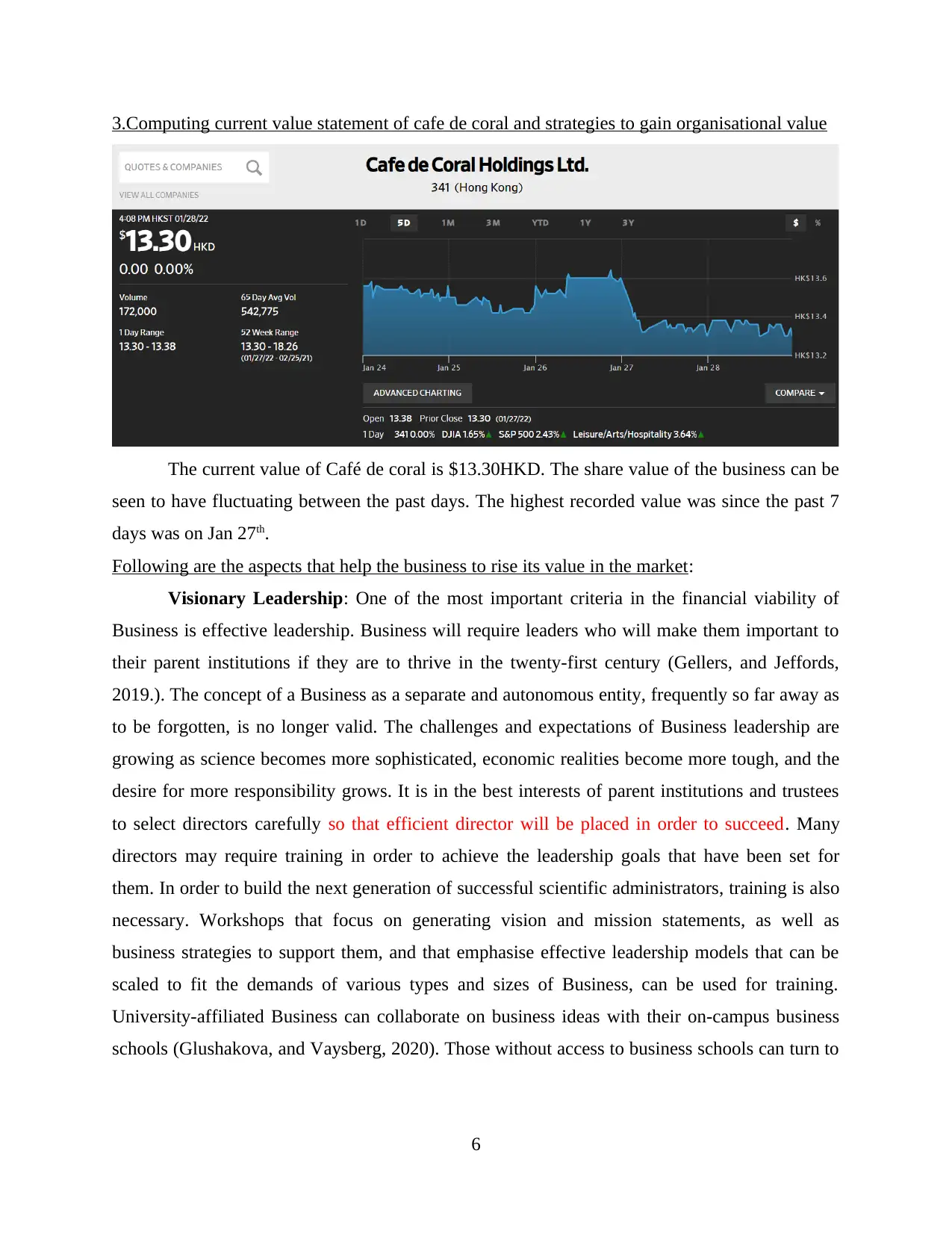
3.Computing current value statement of cafe de coral and strategies to gain organisational value
The current value of Café de coral is $13.30HKD. The share value of the business can be
seen to have fluctuating between the past days. The highest recorded value was since the past 7
days was on Jan 27th.
Following are the aspects that help the business to rise its value in the market:
Visionary Leadership: One of the most important criteria in the financial viability of
Business is effective leadership. Business will require leaders who will make them important to
their parent institutions if they are to thrive in the twenty-first century (Gellers, and Jeffords,
2019.). The concept of a Business as a separate and autonomous entity, frequently so far away as
to be forgotten, is no longer valid. The challenges and expectations of Business leadership are
growing as science becomes more sophisticated, economic realities become more tough, and the
desire for more responsibility grows. It is in the best interests of parent institutions and trustees
to select directors carefully so that efficient director will be placed in order to succeed. Many
directors may require training in order to achieve the leadership goals that have been set for
them. In order to build the next generation of successful scientific administrators, training is also
necessary. Workshops that focus on generating vision and mission statements, as well as
business strategies to support them, and that emphasise effective leadership models that can be
scaled to fit the demands of various types and sizes of Business, can be used for training.
University-affiliated Business can collaborate on business ideas with their on-campus business
schools (Glushakova, and Vaysberg, 2020). Those without access to business schools can turn to
6
The current value of Café de coral is $13.30HKD. The share value of the business can be
seen to have fluctuating between the past days. The highest recorded value was since the past 7
days was on Jan 27th.
Following are the aspects that help the business to rise its value in the market:
Visionary Leadership: One of the most important criteria in the financial viability of
Business is effective leadership. Business will require leaders who will make them important to
their parent institutions if they are to thrive in the twenty-first century (Gellers, and Jeffords,
2019.). The concept of a Business as a separate and autonomous entity, frequently so far away as
to be forgotten, is no longer valid. The challenges and expectations of Business leadership are
growing as science becomes more sophisticated, economic realities become more tough, and the
desire for more responsibility grows. It is in the best interests of parent institutions and trustees
to select directors carefully so that efficient director will be placed in order to succeed. Many
directors may require training in order to achieve the leadership goals that have been set for
them. In order to build the next generation of successful scientific administrators, training is also
necessary. Workshops that focus on generating vision and mission statements, as well as
business strategies to support them, and that emphasise effective leadership models that can be
scaled to fit the demands of various types and sizes of Business, can be used for training.
University-affiliated Business can collaborate on business ideas with their on-campus business
schools (Glushakova, and Vaysberg, 2020). Those without access to business schools can turn to
6
Paraphrase This Document
Need a fresh take? Get an instant paraphrase of this document with our AI Paraphraser
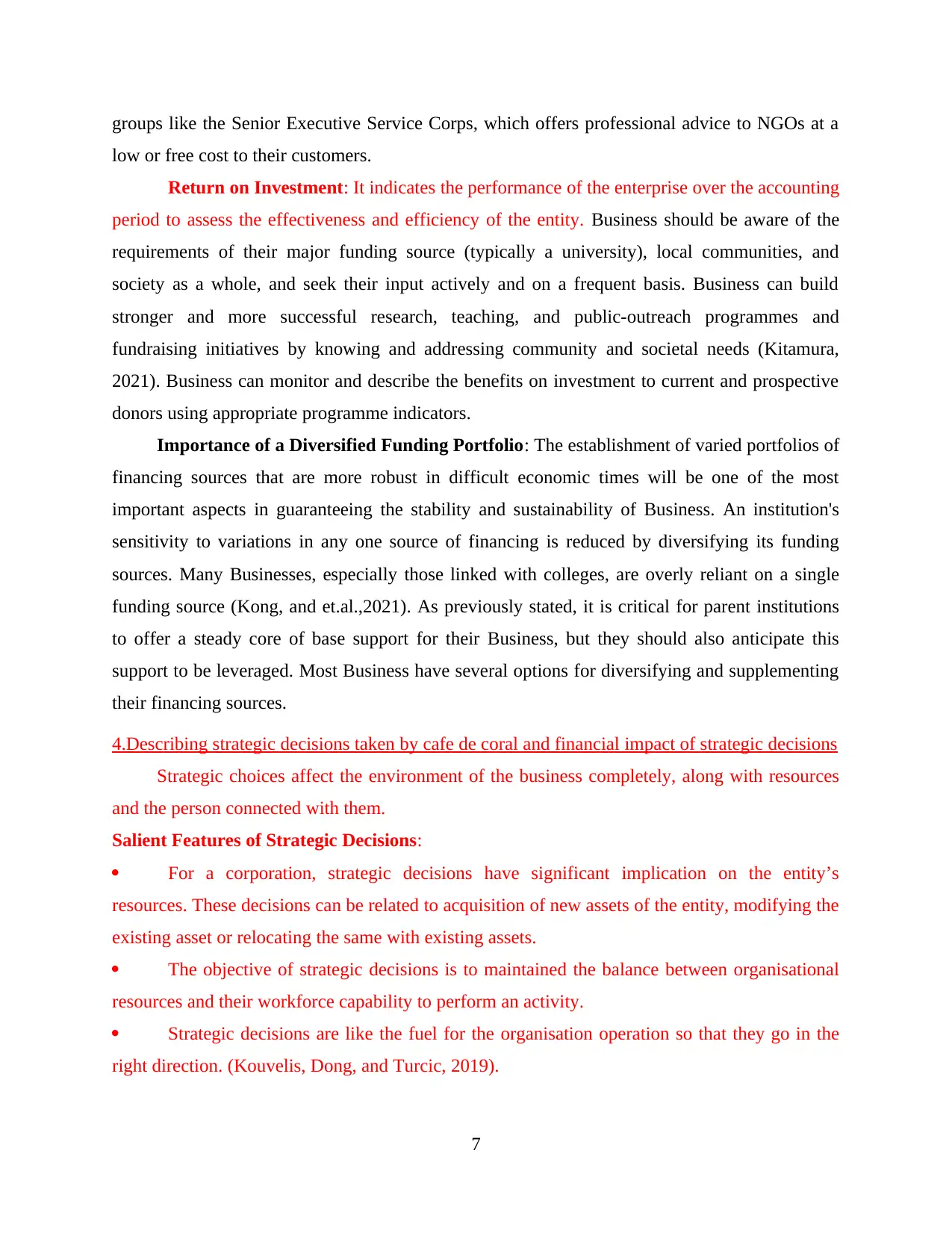
groups like the Senior Executive Service Corps, which offers professional advice to NGOs at a
low or free cost to their customers.
Return on Investment: It indicates the performance of the enterprise over the accounting
period to assess the effectiveness and efficiency of the entity. Business should be aware of the
requirements of their major funding source (typically a university), local communities, and
society as a whole, and seek their input actively and on a frequent basis. Business can build
stronger and more successful research, teaching, and public-outreach programmes and
fundraising initiatives by knowing and addressing community and societal needs (Kitamura,
2021). Business can monitor and describe the benefits on investment to current and prospective
donors using appropriate programme indicators.
Importance of a Diversified Funding Portfolio: The establishment of varied portfolios of
financing sources that are more robust in difficult economic times will be one of the most
important aspects in guaranteeing the stability and sustainability of Business. An institution's
sensitivity to variations in any one source of financing is reduced by diversifying its funding
sources. Many Businesses, especially those linked with colleges, are overly reliant on a single
funding source (Kong, and et.al.,2021). As previously stated, it is critical for parent institutions
to offer a steady core of base support for their Business, but they should also anticipate this
support to be leveraged. Most Business have several options for diversifying and supplementing
their financing sources.
4.Describing strategic decisions taken by cafe de coral and financial impact of strategic decisions
Strategic choices affect the environment of the business completely, along with resources
and the person connected with them.
Salient Features of Strategic Decisions:
For a corporation, strategic decisions have significant implication on the entity’s
resources. These decisions can be related to acquisition of new assets of the entity, modifying the
existing asset or relocating the same with existing assets.
The objective of strategic decisions is to maintained the balance between organisational
resources and their workforce capability to perform an activity.
Strategic decisions are like the fuel for the organisation operation so that they go in the
right direction. (Kouvelis, Dong, and Turcic, 2019).
7
low or free cost to their customers.
Return on Investment: It indicates the performance of the enterprise over the accounting
period to assess the effectiveness and efficiency of the entity. Business should be aware of the
requirements of their major funding source (typically a university), local communities, and
society as a whole, and seek their input actively and on a frequent basis. Business can build
stronger and more successful research, teaching, and public-outreach programmes and
fundraising initiatives by knowing and addressing community and societal needs (Kitamura,
2021). Business can monitor and describe the benefits on investment to current and prospective
donors using appropriate programme indicators.
Importance of a Diversified Funding Portfolio: The establishment of varied portfolios of
financing sources that are more robust in difficult economic times will be one of the most
important aspects in guaranteeing the stability and sustainability of Business. An institution's
sensitivity to variations in any one source of financing is reduced by diversifying its funding
sources. Many Businesses, especially those linked with colleges, are overly reliant on a single
funding source (Kong, and et.al.,2021). As previously stated, it is critical for parent institutions
to offer a steady core of base support for their Business, but they should also anticipate this
support to be leveraged. Most Business have several options for diversifying and supplementing
their financing sources.
4.Describing strategic decisions taken by cafe de coral and financial impact of strategic decisions
Strategic choices affect the environment of the business completely, along with resources
and the person connected with them.
Salient Features of Strategic Decisions:
For a corporation, strategic decisions have significant implication on the entity’s
resources. These decisions can be related to acquisition of new assets of the entity, modifying the
existing asset or relocating the same with existing assets.
The objective of strategic decisions is to maintained the balance between organisational
resources and their workforce capability to perform an activity.
Strategic decisions are like the fuel for the organisation operation so that they go in the
right direction. (Kouvelis, Dong, and Turcic, 2019).
7
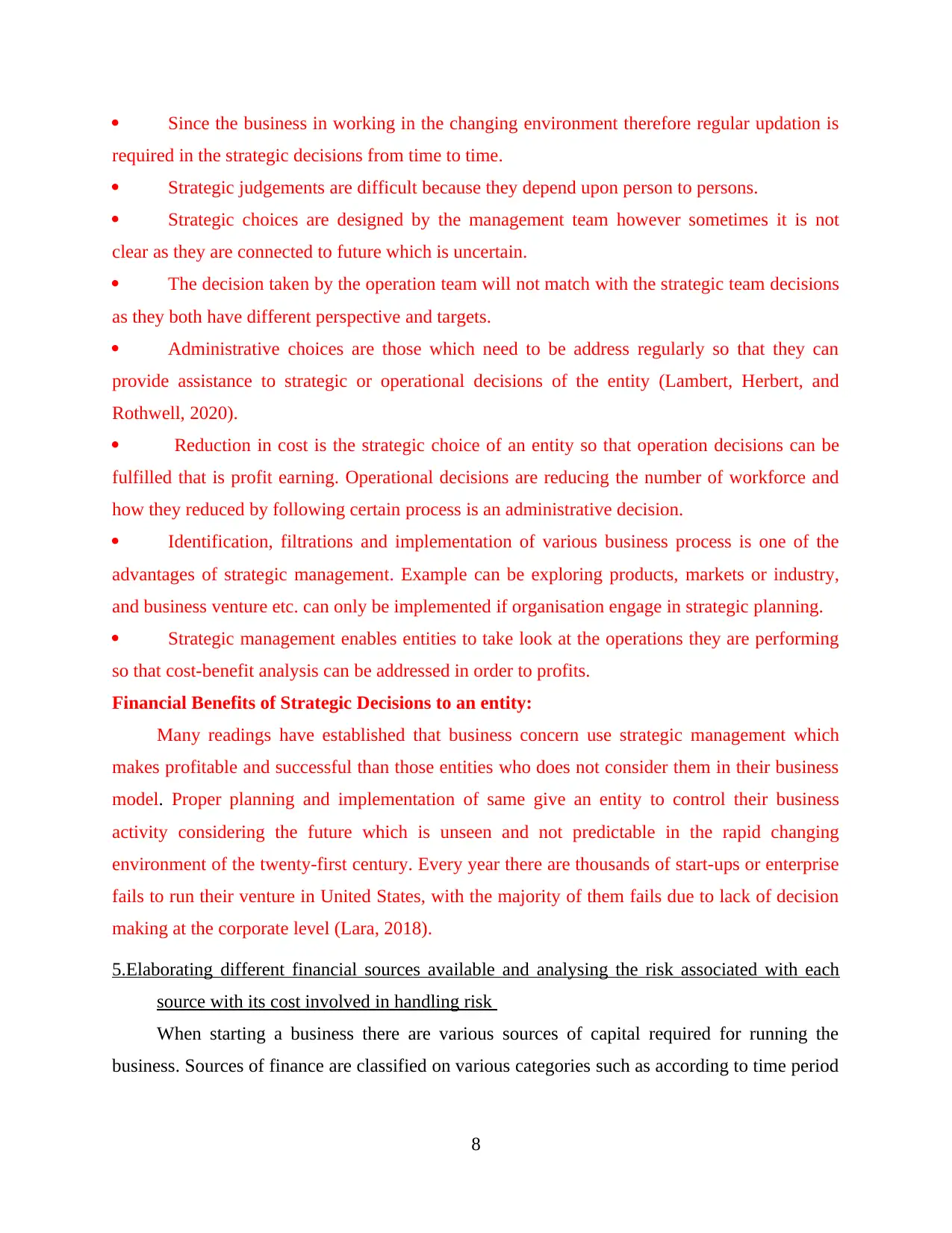
Since the business in working in the changing environment therefore regular updation is
required in the strategic decisions from time to time.
Strategic judgements are difficult because they depend upon person to persons.
Strategic choices are designed by the management team however sometimes it is not
clear as they are connected to future which is uncertain.
The decision taken by the operation team will not match with the strategic team decisions
as they both have different perspective and targets.
Administrative choices are those which need to be address regularly so that they can
provide assistance to strategic or operational decisions of the entity (Lambert, Herbert, and
Rothwell, 2020).
Reduction in cost is the strategic choice of an entity so that operation decisions can be
fulfilled that is profit earning. Operational decisions are reducing the number of workforce and
how they reduced by following certain process is an administrative decision.
Identification, filtrations and implementation of various business process is one of the
advantages of strategic management. Example can be exploring products, markets or industry,
and business venture etc. can only be implemented if organisation engage in strategic planning.
Strategic management enables entities to take look at the operations they are performing
so that cost-benefit analysis can be addressed in order to profits.
Financial Benefits of Strategic Decisions to an entity:
Many readings have established that business concern use strategic management which
makes profitable and successful than those entities who does not consider them in their business
model. Proper planning and implementation of same give an entity to control their business
activity considering the future which is unseen and not predictable in the rapid changing
environment of the twenty-first century. Every year there are thousands of start-ups or enterprise
fails to run their venture in United States, with the majority of them fails due to lack of decision
making at the corporate level (Lara, 2018).
5.Elaborating different financial sources available and analysing the risk associated with each
source with its cost involved in handling risk
When starting a business there are various sources of capital required for running the
business. Sources of finance are classified on various categories such as according to time period
8
required in the strategic decisions from time to time.
Strategic judgements are difficult because they depend upon person to persons.
Strategic choices are designed by the management team however sometimes it is not
clear as they are connected to future which is uncertain.
The decision taken by the operation team will not match with the strategic team decisions
as they both have different perspective and targets.
Administrative choices are those which need to be address regularly so that they can
provide assistance to strategic or operational decisions of the entity (Lambert, Herbert, and
Rothwell, 2020).
Reduction in cost is the strategic choice of an entity so that operation decisions can be
fulfilled that is profit earning. Operational decisions are reducing the number of workforce and
how they reduced by following certain process is an administrative decision.
Identification, filtrations and implementation of various business process is one of the
advantages of strategic management. Example can be exploring products, markets or industry,
and business venture etc. can only be implemented if organisation engage in strategic planning.
Strategic management enables entities to take look at the operations they are performing
so that cost-benefit analysis can be addressed in order to profits.
Financial Benefits of Strategic Decisions to an entity:
Many readings have established that business concern use strategic management which
makes profitable and successful than those entities who does not consider them in their business
model. Proper planning and implementation of same give an entity to control their business
activity considering the future which is unseen and not predictable in the rapid changing
environment of the twenty-first century. Every year there are thousands of start-ups or enterprise
fails to run their venture in United States, with the majority of them fails due to lack of decision
making at the corporate level (Lara, 2018).
5.Elaborating different financial sources available and analysing the risk associated with each
source with its cost involved in handling risk
When starting a business there are various sources of capital required for running the
business. Sources of finance are classified on various categories such as according to time period
8
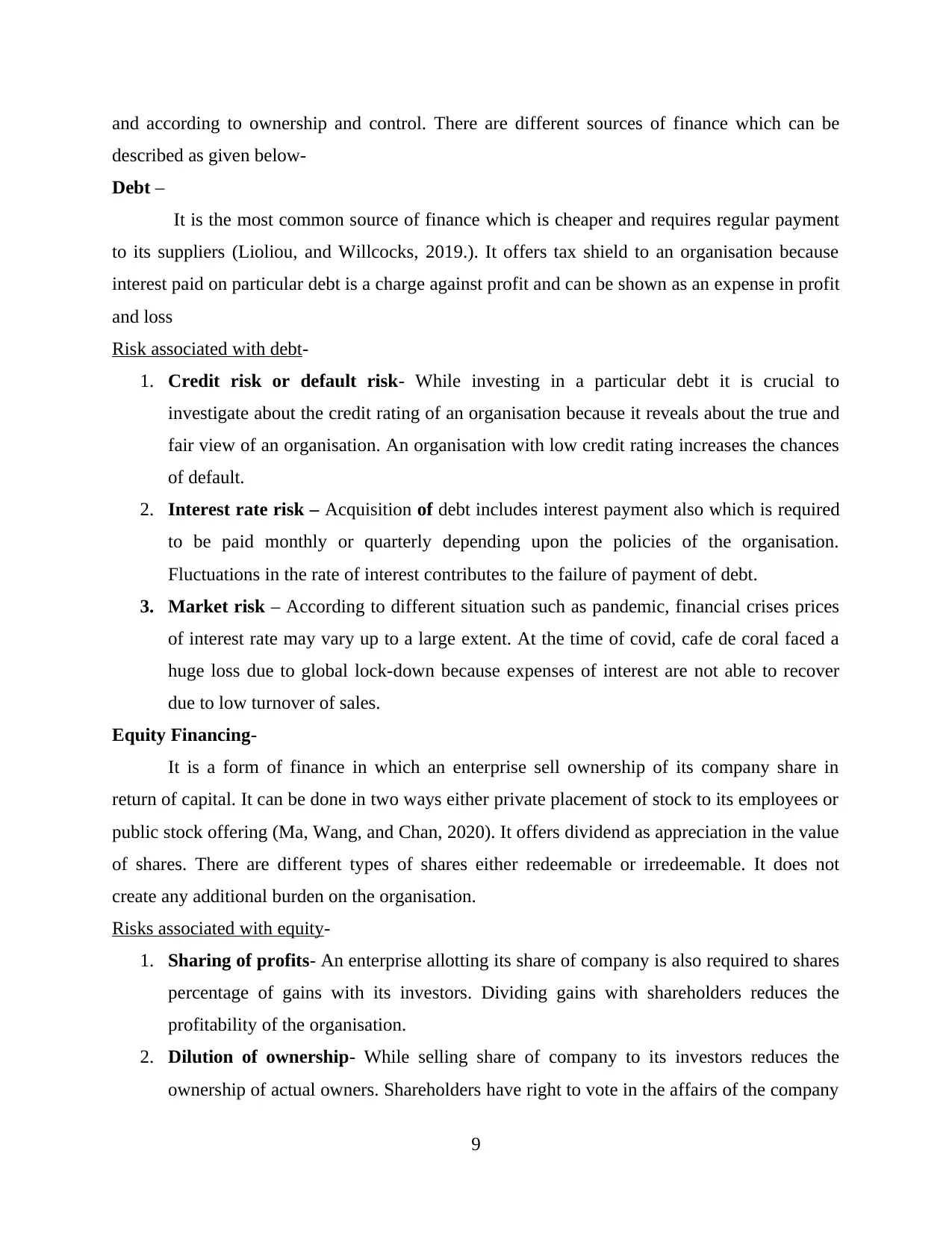
and according to ownership and control. There are different sources of finance which can be
described as given below-
Debt –
It is the most common source of finance which is cheaper and requires regular payment
to its suppliers (Lioliou, and Willcocks, 2019.). It offers tax shield to an organisation because
interest paid on particular debt is a charge against profit and can be shown as an expense in profit
and loss
Risk associated with debt-
1. Credit risk or default risk- While investing in a particular debt it is crucial to
investigate about the credit rating of an organisation because it reveals about the true and
fair view of an organisation. An organisation with low credit rating increases the chances
of default.
2. Interest rate risk – Acquisition of debt includes interest payment also which is required
to be paid monthly or quarterly depending upon the policies of the organisation.
Fluctuations in the rate of interest contributes to the failure of payment of debt.
3. Market risk – According to different situation such as pandemic, financial crises prices
of interest rate may vary up to a large extent. At the time of covid, cafe de coral faced a
huge loss due to global lock-down because expenses of interest are not able to recover
due to low turnover of sales.
Equity Financing-
It is a form of finance in which an enterprise sell ownership of its company share in
return of capital. It can be done in two ways either private placement of stock to its employees or
public stock offering (Ma, Wang, and Chan, 2020). It offers dividend as appreciation in the value
of shares. There are different types of shares either redeemable or irredeemable. It does not
create any additional burden on the organisation.
Risks associated with equity-
1. Sharing of profits- An enterprise allotting its share of company is also required to shares
percentage of gains with its investors. Dividing gains with shareholders reduces the
profitability of the organisation.
2. Dilution of ownership- While selling share of company to its investors reduces the
ownership of actual owners. Shareholders have right to vote in the affairs of the company
9
described as given below-
Debt –
It is the most common source of finance which is cheaper and requires regular payment
to its suppliers (Lioliou, and Willcocks, 2019.). It offers tax shield to an organisation because
interest paid on particular debt is a charge against profit and can be shown as an expense in profit
and loss
Risk associated with debt-
1. Credit risk or default risk- While investing in a particular debt it is crucial to
investigate about the credit rating of an organisation because it reveals about the true and
fair view of an organisation. An organisation with low credit rating increases the chances
of default.
2. Interest rate risk – Acquisition of debt includes interest payment also which is required
to be paid monthly or quarterly depending upon the policies of the organisation.
Fluctuations in the rate of interest contributes to the failure of payment of debt.
3. Market risk – According to different situation such as pandemic, financial crises prices
of interest rate may vary up to a large extent. At the time of covid, cafe de coral faced a
huge loss due to global lock-down because expenses of interest are not able to recover
due to low turnover of sales.
Equity Financing-
It is a form of finance in which an enterprise sell ownership of its company share in
return of capital. It can be done in two ways either private placement of stock to its employees or
public stock offering (Ma, Wang, and Chan, 2020). It offers dividend as appreciation in the value
of shares. There are different types of shares either redeemable or irredeemable. It does not
create any additional burden on the organisation.
Risks associated with equity-
1. Sharing of profits- An enterprise allotting its share of company is also required to shares
percentage of gains with its investors. Dividing gains with shareholders reduces the
profitability of the organisation.
2. Dilution of ownership- While selling share of company to its investors reduces the
ownership of actual owners. Shareholders have right to vote in the affairs of the company
9
Secure Best Marks with AI Grader
Need help grading? Try our AI Grader for instant feedback on your assignments.
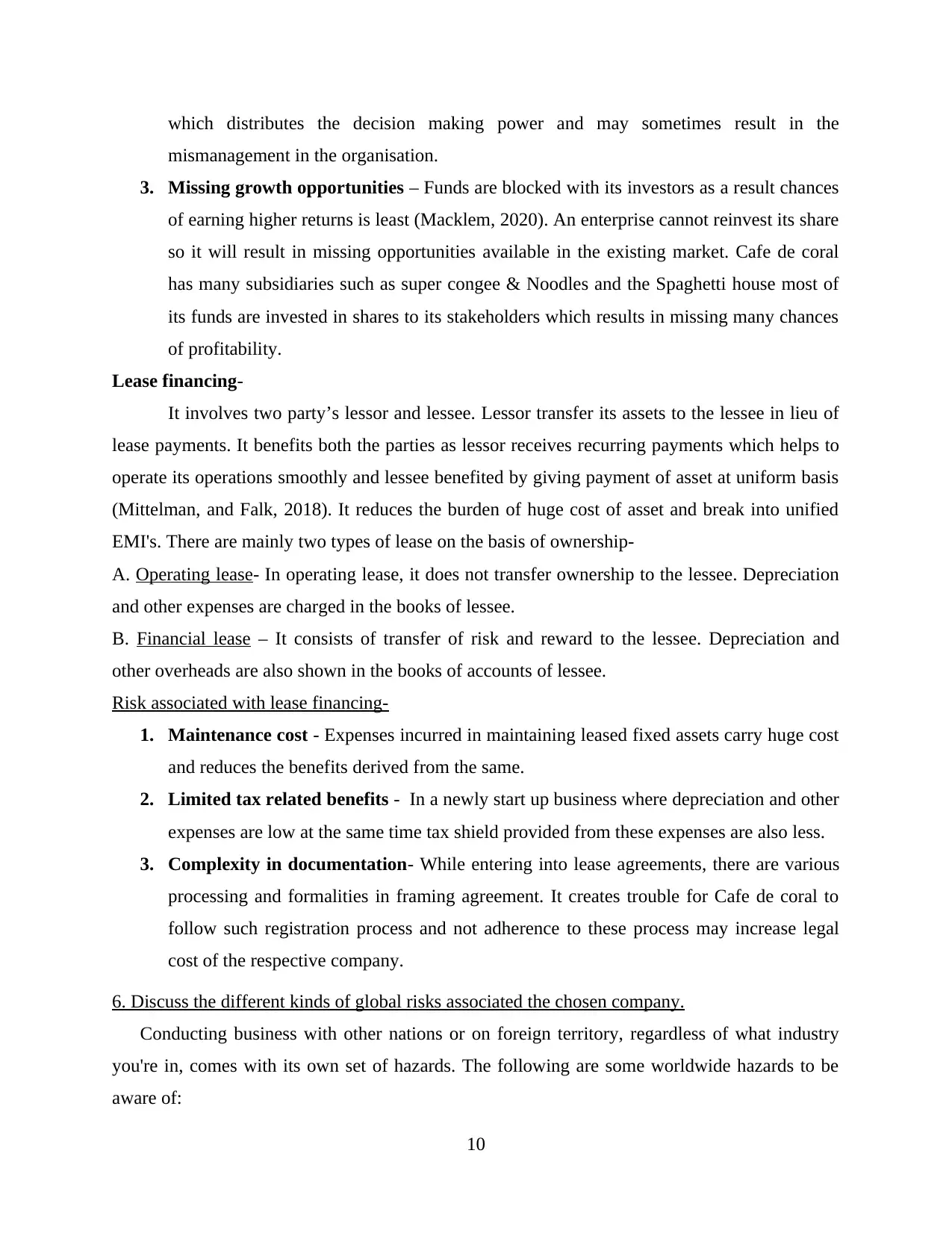
which distributes the decision making power and may sometimes result in the
mismanagement in the organisation.
3. Missing growth opportunities – Funds are blocked with its investors as a result chances
of earning higher returns is least (Macklem, 2020). An enterprise cannot reinvest its share
so it will result in missing opportunities available in the existing market. Cafe de coral
has many subsidiaries such as super congee & Noodles and the Spaghetti house most of
its funds are invested in shares to its stakeholders which results in missing many chances
of profitability.
Lease financing-
It involves two party’s lessor and lessee. Lessor transfer its assets to the lessee in lieu of
lease payments. It benefits both the parties as lessor receives recurring payments which helps to
operate its operations smoothly and lessee benefited by giving payment of asset at uniform basis
(Mittelman, and Falk, 2018). It reduces the burden of huge cost of asset and break into unified
EMI's. There are mainly two types of lease on the basis of ownership-
A. Operating lease- In operating lease, it does not transfer ownership to the lessee. Depreciation
and other expenses are charged in the books of lessee.
B. Financial lease – It consists of transfer of risk and reward to the lessee. Depreciation and
other overheads are also shown in the books of accounts of lessee.
Risk associated with lease financing-
1. Maintenance cost - Expenses incurred in maintaining leased fixed assets carry huge cost
and reduces the benefits derived from the same.
2. Limited tax related benefits - In a newly start up business where depreciation and other
expenses are low at the same time tax shield provided from these expenses are also less.
3. Complexity in documentation- While entering into lease agreements, there are various
processing and formalities in framing agreement. It creates trouble for Cafe de coral to
follow such registration process and not adherence to these process may increase legal
cost of the respective company.
6. Discuss the different kinds of global risks associated the chosen company.
Conducting business with other nations or on foreign territory, regardless of what industry
you're in, comes with its own set of hazards. The following are some worldwide hazards to be
aware of:
10
mismanagement in the organisation.
3. Missing growth opportunities – Funds are blocked with its investors as a result chances
of earning higher returns is least (Macklem, 2020). An enterprise cannot reinvest its share
so it will result in missing opportunities available in the existing market. Cafe de coral
has many subsidiaries such as super congee & Noodles and the Spaghetti house most of
its funds are invested in shares to its stakeholders which results in missing many chances
of profitability.
Lease financing-
It involves two party’s lessor and lessee. Lessor transfer its assets to the lessee in lieu of
lease payments. It benefits both the parties as lessor receives recurring payments which helps to
operate its operations smoothly and lessee benefited by giving payment of asset at uniform basis
(Mittelman, and Falk, 2018). It reduces the burden of huge cost of asset and break into unified
EMI's. There are mainly two types of lease on the basis of ownership-
A. Operating lease- In operating lease, it does not transfer ownership to the lessee. Depreciation
and other expenses are charged in the books of lessee.
B. Financial lease – It consists of transfer of risk and reward to the lessee. Depreciation and
other overheads are also shown in the books of accounts of lessee.
Risk associated with lease financing-
1. Maintenance cost - Expenses incurred in maintaining leased fixed assets carry huge cost
and reduces the benefits derived from the same.
2. Limited tax related benefits - In a newly start up business where depreciation and other
expenses are low at the same time tax shield provided from these expenses are also less.
3. Complexity in documentation- While entering into lease agreements, there are various
processing and formalities in framing agreement. It creates trouble for Cafe de coral to
follow such registration process and not adherence to these process may increase legal
cost of the respective company.
6. Discuss the different kinds of global risks associated the chosen company.
Conducting business with other nations or on foreign territory, regardless of what industry
you're in, comes with its own set of hazards. The following are some worldwide hazards to be
aware of:
10
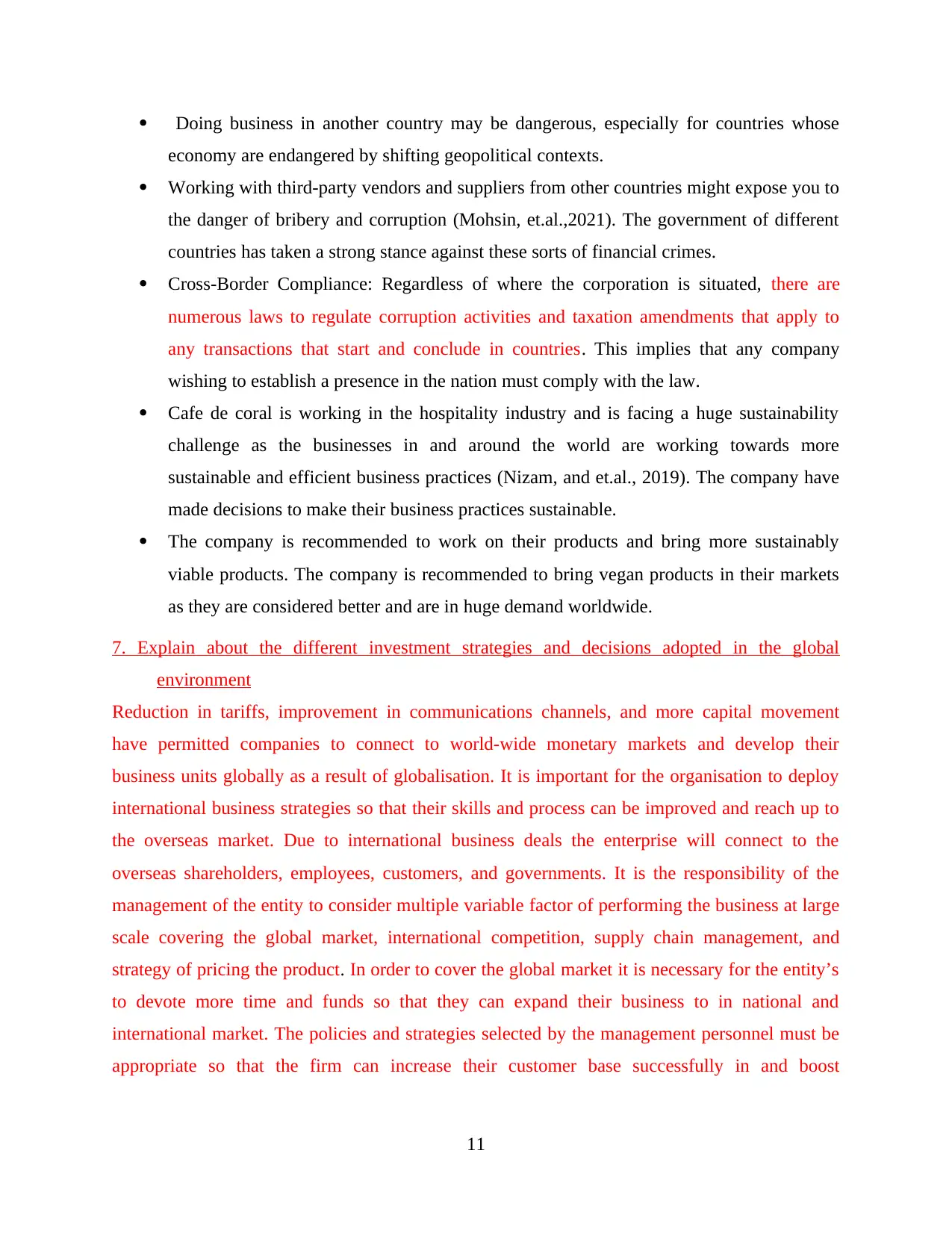
Doing business in another country may be dangerous, especially for countries whose
economy are endangered by shifting geopolitical contexts.
Working with third-party vendors and suppliers from other countries might expose you to
the danger of bribery and corruption (Mohsin, et.al.,2021). The government of different
countries has taken a strong stance against these sorts of financial crimes.
Cross-Border Compliance: Regardless of where the corporation is situated, there are
numerous laws to regulate corruption activities and taxation amendments that apply to
any transactions that start and conclude in countries. This implies that any company
wishing to establish a presence in the nation must comply with the law.
Cafe de coral is working in the hospitality industry and is facing a huge sustainability
challenge as the businesses in and around the world are working towards more
sustainable and efficient business practices (Nizam, and et.al., 2019). The company have
made decisions to make their business practices sustainable.
The company is recommended to work on their products and bring more sustainably
viable products. The company is recommended to bring vegan products in their markets
as they are considered better and are in huge demand worldwide.
7. Explain about the different investment strategies and decisions adopted in the global
environment
Reduction in tariffs, improvement in communications channels, and more capital movement
have permitted companies to connect to world-wide monetary markets and develop their
business units globally as a result of globalisation. It is important for the organisation to deploy
international business strategies so that their skills and process can be improved and reach up to
the overseas market. Due to international business deals the enterprise will connect to the
overseas shareholders, employees, customers, and governments. It is the responsibility of the
management of the entity to consider multiple variable factor of performing the business at large
scale covering the global market, international competition, supply chain management, and
strategy of pricing the product. In order to cover the global market it is necessary for the entity’s
to devote more time and funds so that they can expand their business to in national and
international market. The policies and strategies selected by the management personnel must be
appropriate so that the firm can increase their customer base successfully in and boost
11
economy are endangered by shifting geopolitical contexts.
Working with third-party vendors and suppliers from other countries might expose you to
the danger of bribery and corruption (Mohsin, et.al.,2021). The government of different
countries has taken a strong stance against these sorts of financial crimes.
Cross-Border Compliance: Regardless of where the corporation is situated, there are
numerous laws to regulate corruption activities and taxation amendments that apply to
any transactions that start and conclude in countries. This implies that any company
wishing to establish a presence in the nation must comply with the law.
Cafe de coral is working in the hospitality industry and is facing a huge sustainability
challenge as the businesses in and around the world are working towards more
sustainable and efficient business practices (Nizam, and et.al., 2019). The company have
made decisions to make their business practices sustainable.
The company is recommended to work on their products and bring more sustainably
viable products. The company is recommended to bring vegan products in their markets
as they are considered better and are in huge demand worldwide.
7. Explain about the different investment strategies and decisions adopted in the global
environment
Reduction in tariffs, improvement in communications channels, and more capital movement
have permitted companies to connect to world-wide monetary markets and develop their
business units globally as a result of globalisation. It is important for the organisation to deploy
international business strategies so that their skills and process can be improved and reach up to
the overseas market. Due to international business deals the enterprise will connect to the
overseas shareholders, employees, customers, and governments. It is the responsibility of the
management of the entity to consider multiple variable factor of performing the business at large
scale covering the global market, international competition, supply chain management, and
strategy of pricing the product. In order to cover the global market it is necessary for the entity’s
to devote more time and funds so that they can expand their business to in national and
international market. The policies and strategies selected by the management personnel must be
appropriate so that the firm can increase their customer base successfully in and boost
11
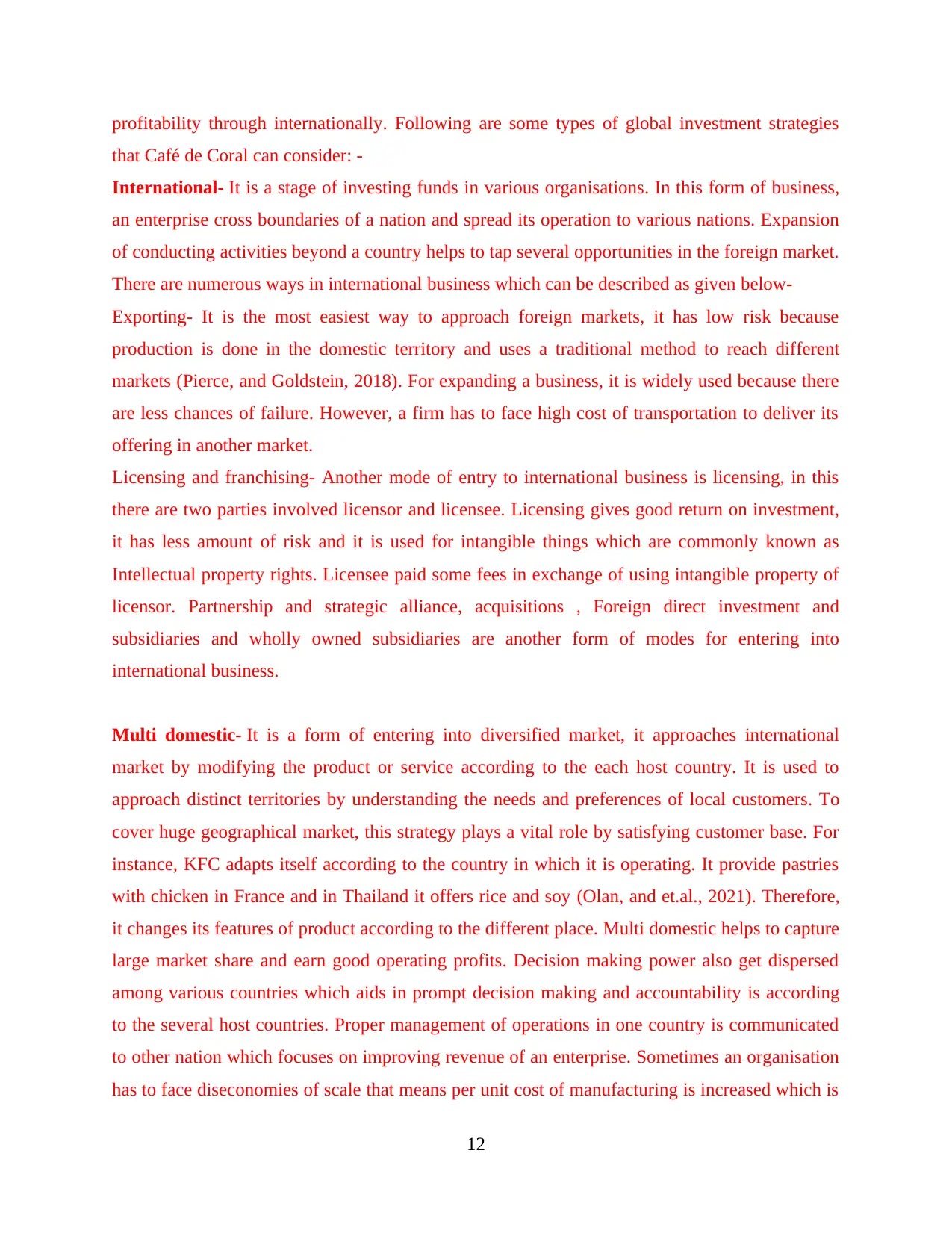
profitability through internationally. Following are some types of global investment strategies
that Café de Coral can consider: -
International- It is a stage of investing funds in various organisations. In this form of business,
an enterprise cross boundaries of a nation and spread its operation to various nations. Expansion
of conducting activities beyond a country helps to tap several opportunities in the foreign market.
There are numerous ways in international business which can be described as given below-
Exporting- It is the most easiest way to approach foreign markets, it has low risk because
production is done in the domestic territory and uses a traditional method to reach different
markets (Pierce, and Goldstein, 2018). For expanding a business, it is widely used because there
are less chances of failure. However, a firm has to face high cost of transportation to deliver its
offering in another market.
Licensing and franchising- Another mode of entry to international business is licensing, in this
there are two parties involved licensor and licensee. Licensing gives good return on investment,
it has less amount of risk and it is used for intangible things which are commonly known as
Intellectual property rights. Licensee paid some fees in exchange of using intangible property of
licensor. Partnership and strategic alliance, acquisitions , Foreign direct investment and
subsidiaries and wholly owned subsidiaries are another form of modes for entering into
international business.
Multi domestic- It is a form of entering into diversified market, it approaches international
market by modifying the product or service according to the each host country. It is used to
approach distinct territories by understanding the needs and preferences of local customers. To
cover huge geographical market, this strategy plays a vital role by satisfying customer base. For
instance, KFC adapts itself according to the country in which it is operating. It provide pastries
with chicken in France and in Thailand it offers rice and soy (Olan, and et.al., 2021). Therefore,
it changes its features of product according to the different place. Multi domestic helps to capture
large market share and earn good operating profits. Decision making power also get dispersed
among various countries which aids in prompt decision making and accountability is according
to the several host countries. Proper management of operations in one country is communicated
to other nation which focuses on improving revenue of an enterprise. Sometimes an organisation
has to face diseconomies of scale that means per unit cost of manufacturing is increased which is
12
that Café de Coral can consider: -
International- It is a stage of investing funds in various organisations. In this form of business,
an enterprise cross boundaries of a nation and spread its operation to various nations. Expansion
of conducting activities beyond a country helps to tap several opportunities in the foreign market.
There are numerous ways in international business which can be described as given below-
Exporting- It is the most easiest way to approach foreign markets, it has low risk because
production is done in the domestic territory and uses a traditional method to reach different
markets (Pierce, and Goldstein, 2018). For expanding a business, it is widely used because there
are less chances of failure. However, a firm has to face high cost of transportation to deliver its
offering in another market.
Licensing and franchising- Another mode of entry to international business is licensing, in this
there are two parties involved licensor and licensee. Licensing gives good return on investment,
it has less amount of risk and it is used for intangible things which are commonly known as
Intellectual property rights. Licensee paid some fees in exchange of using intangible property of
licensor. Partnership and strategic alliance, acquisitions , Foreign direct investment and
subsidiaries and wholly owned subsidiaries are another form of modes for entering into
international business.
Multi domestic- It is a form of entering into diversified market, it approaches international
market by modifying the product or service according to the each host country. It is used to
approach distinct territories by understanding the needs and preferences of local customers. To
cover huge geographical market, this strategy plays a vital role by satisfying customer base. For
instance, KFC adapts itself according to the country in which it is operating. It provide pastries
with chicken in France and in Thailand it offers rice and soy (Olan, and et.al., 2021). Therefore,
it changes its features of product according to the different place. Multi domestic helps to capture
large market share and earn good operating profits. Decision making power also get dispersed
among various countries which aids in prompt decision making and accountability is according
to the several host countries. Proper management of operations in one country is communicated
to other nation which focuses on improving revenue of an enterprise. Sometimes an organisation
has to face diseconomies of scale that means per unit cost of manufacturing is increased which is
12
Paraphrase This Document
Need a fresh take? Get an instant paraphrase of this document with our AI Paraphraser
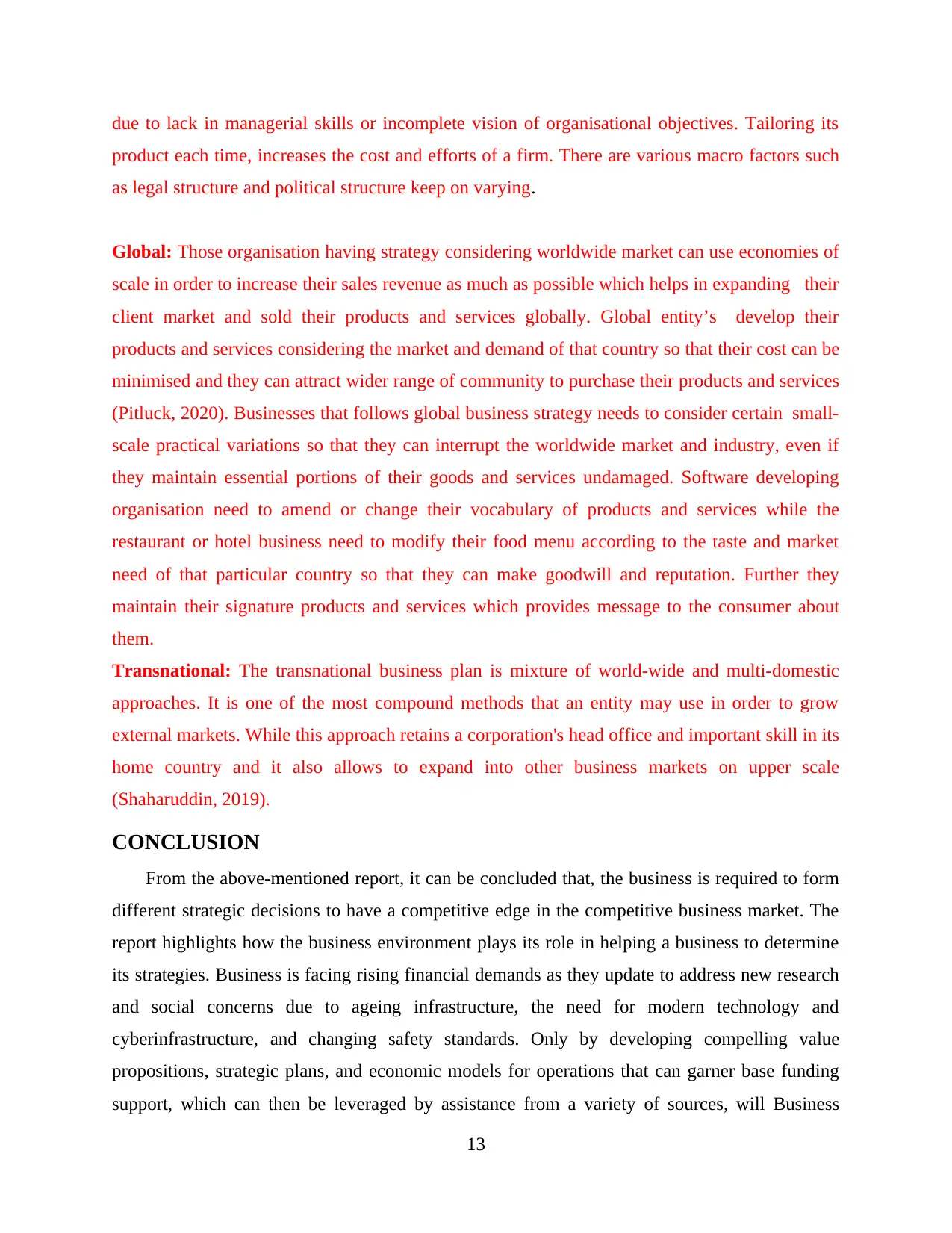
due to lack in managerial skills or incomplete vision of organisational objectives. Tailoring its
product each time, increases the cost and efforts of a firm. There are various macro factors such
as legal structure and political structure keep on varying.
Global: Those organisation having strategy considering worldwide market can use economies of
scale in order to increase their sales revenue as much as possible which helps in expanding their
client market and sold their products and services globally. Global entity’s develop their
products and services considering the market and demand of that country so that their cost can be
minimised and they can attract wider range of community to purchase their products and services
(Pitluck, 2020). Businesses that follows global business strategy needs to consider certain small-
scale practical variations so that they can interrupt the worldwide market and industry, even if
they maintain essential portions of their goods and services undamaged. Software developing
organisation need to amend or change their vocabulary of products and services while the
restaurant or hotel business need to modify their food menu according to the taste and market
need of that particular country so that they can make goodwill and reputation. Further they
maintain their signature products and services which provides message to the consumer about
them.
Transnational: The transnational business plan is mixture of world-wide and multi-domestic
approaches. It is one of the most compound methods that an entity may use in order to grow
external markets. While this approach retains a corporation's head office and important skill in its
home country and it also allows to expand into other business markets on upper scale
(Shaharuddin, 2019).
CONCLUSION
From the above-mentioned report, it can be concluded that, the business is required to form
different strategic decisions to have a competitive edge in the competitive business market. The
report highlights how the business environment plays its role in helping a business to determine
its strategies. Business is facing rising financial demands as they update to address new research
and social concerns due to ageing infrastructure, the need for modern technology and
cyberinfrastructure, and changing safety standards. Only by developing compelling value
propositions, strategic plans, and economic models for operations that can garner base funding
support, which can then be leveraged by assistance from a variety of sources, will Business
13
product each time, increases the cost and efforts of a firm. There are various macro factors such
as legal structure and political structure keep on varying.
Global: Those organisation having strategy considering worldwide market can use economies of
scale in order to increase their sales revenue as much as possible which helps in expanding their
client market and sold their products and services globally. Global entity’s develop their
products and services considering the market and demand of that country so that their cost can be
minimised and they can attract wider range of community to purchase their products and services
(Pitluck, 2020). Businesses that follows global business strategy needs to consider certain small-
scale practical variations so that they can interrupt the worldwide market and industry, even if
they maintain essential portions of their goods and services undamaged. Software developing
organisation need to amend or change their vocabulary of products and services while the
restaurant or hotel business need to modify their food menu according to the taste and market
need of that particular country so that they can make goodwill and reputation. Further they
maintain their signature products and services which provides message to the consumer about
them.
Transnational: The transnational business plan is mixture of world-wide and multi-domestic
approaches. It is one of the most compound methods that an entity may use in order to grow
external markets. While this approach retains a corporation's head office and important skill in its
home country and it also allows to expand into other business markets on upper scale
(Shaharuddin, 2019).
CONCLUSION
From the above-mentioned report, it can be concluded that, the business is required to form
different strategic decisions to have a competitive edge in the competitive business market. The
report highlights how the business environment plays its role in helping a business to determine
its strategies. Business is facing rising financial demands as they update to address new research
and social concerns due to ageing infrastructure, the need for modern technology and
cyberinfrastructure, and changing safety standards. Only by developing compelling value
propositions, strategic plans, and economic models for operations that can garner base funding
support, which can then be leveraged by assistance from a variety of sources, will Business
13
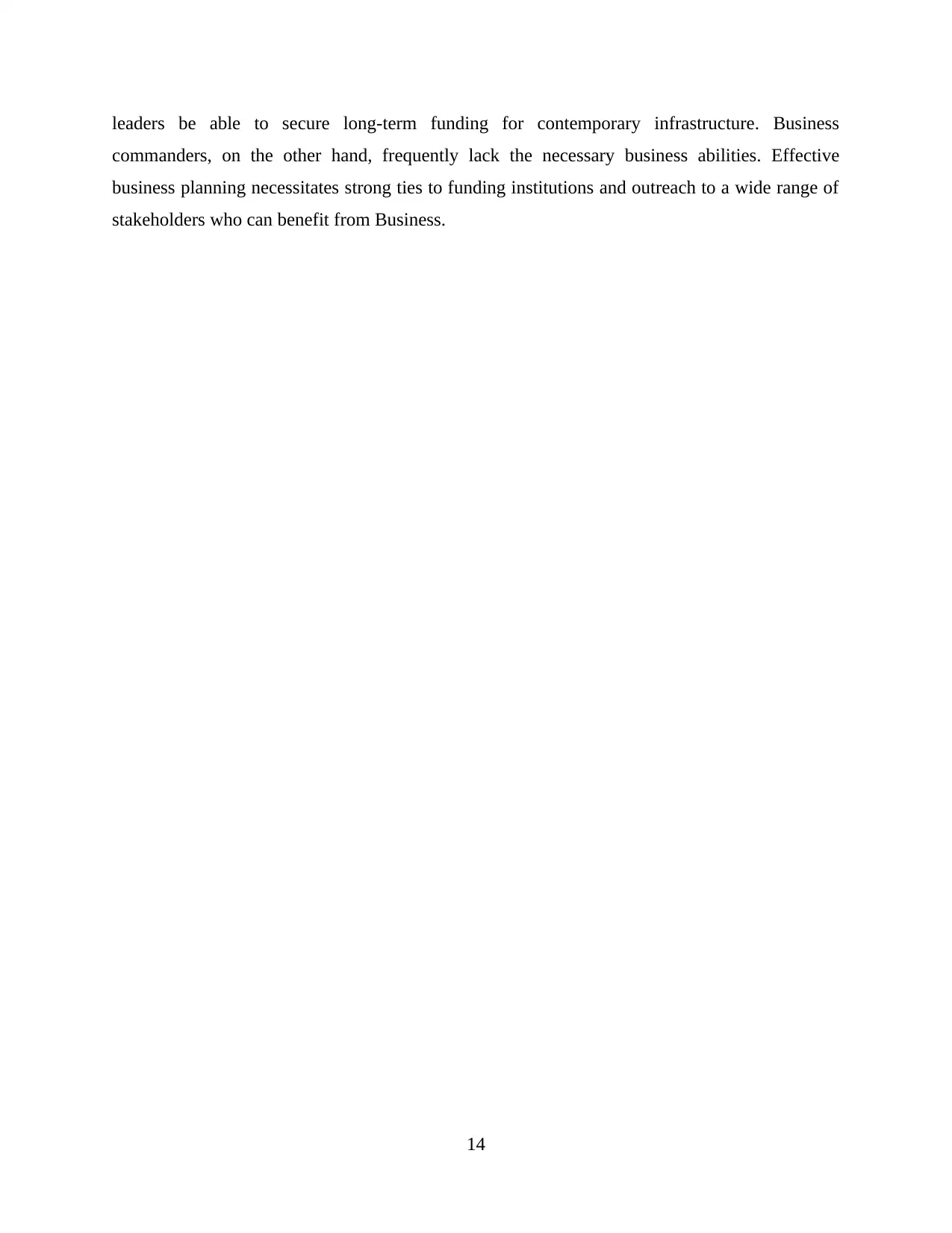
leaders be able to secure long-term funding for contemporary infrastructure. Business
commanders, on the other hand, frequently lack the necessary business abilities. Effective
business planning necessitates strong ties to funding institutions and outreach to a wide range of
stakeholders who can benefit from Business.
14
commanders, on the other hand, frequently lack the necessary business abilities. Effective
business planning necessitates strong ties to funding institutions and outreach to a wide range of
stakeholders who can benefit from Business.
14
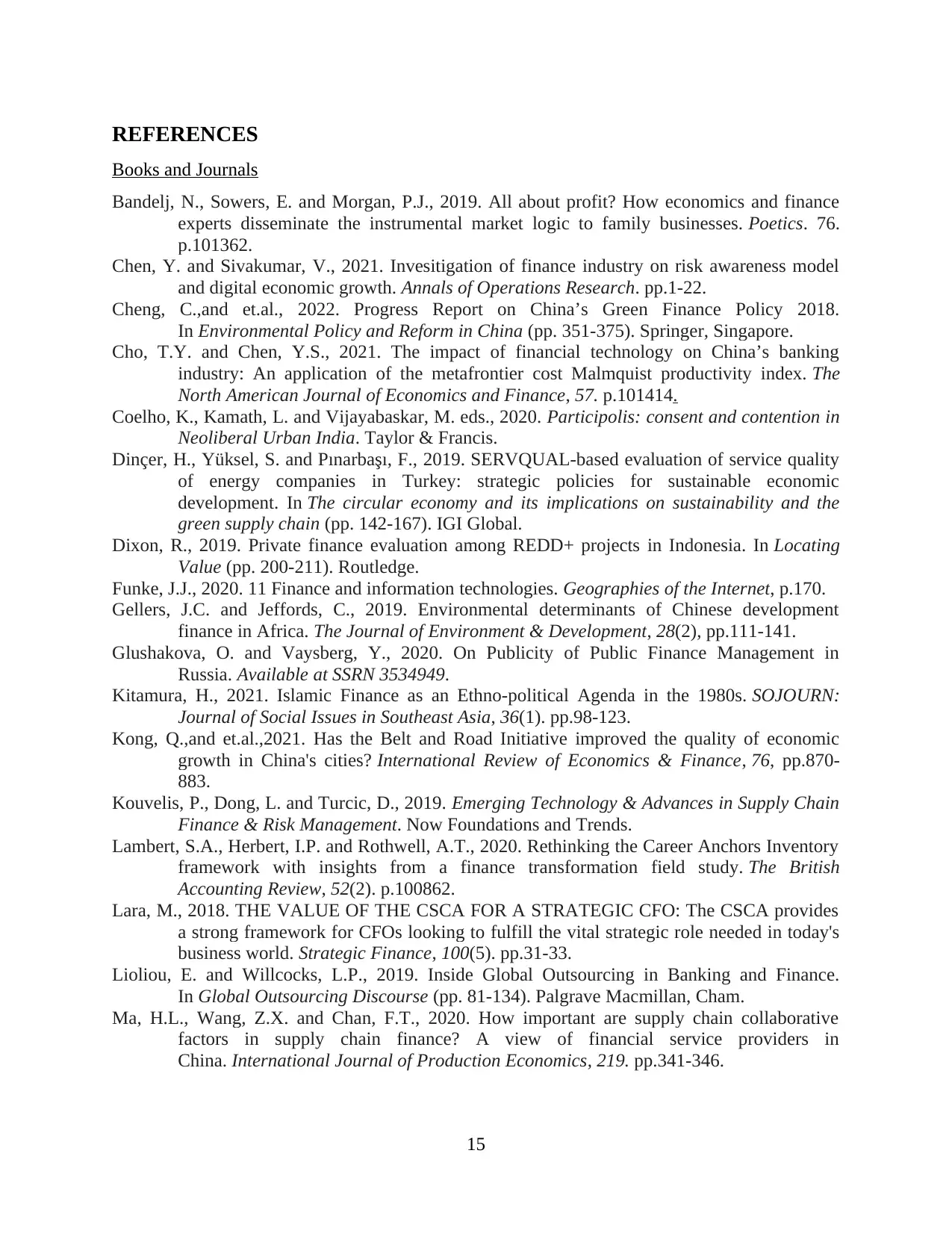
REFERENCES
Books and Journals
Bandelj, N., Sowers, E. and Morgan, P.J., 2019. All about profit? How economics and finance
experts disseminate the instrumental market logic to family businesses. Poetics. 76.
p.101362.
Chen, Y. and Sivakumar, V., 2021. Invesitigation of finance industry on risk awareness model
and digital economic growth. Annals of Operations Research. pp.1-22.
Cheng, C.,and et.al., 2022. Progress Report on China’s Green Finance Policy 2018.
In Environmental Policy and Reform in China (pp. 351-375). Springer, Singapore.
Cho, T.Y. and Chen, Y.S., 2021. The impact of financial technology on China’s banking
industry: An application of the metafrontier cost Malmquist productivity index. The
North American Journal of Economics and Finance, 57. p.101414.
Coelho, K., Kamath, L. and Vijayabaskar, M. eds., 2020. Participolis: consent and contention in
Neoliberal Urban India. Taylor & Francis.
Dinçer, H., Yüksel, S. and Pınarbaşı, F., 2019. SERVQUAL-based evaluation of service quality
of energy companies in Turkey: strategic policies for sustainable economic
development. In The circular economy and its implications on sustainability and the
green supply chain (pp. 142-167). IGI Global.
Dixon, R., 2019. Private finance evaluation among REDD+ projects in Indonesia. In Locating
Value (pp. 200-211). Routledge.
Funke, J.J., 2020. 11 Finance and information technologies. Geographies of the Internet, p.170.
Gellers, J.C. and Jeffords, C., 2019. Environmental determinants of Chinese development
finance in Africa. The Journal of Environment & Development, 28(2), pp.111-141.
Glushakova, O. and Vaysberg, Y., 2020. On Publicity of Public Finance Management in
Russia. Available at SSRN 3534949.
Kitamura, H., 2021. Islamic Finance as an Ethno-political Agenda in the 1980s. SOJOURN:
Journal of Social Issues in Southeast Asia, 36(1). pp.98-123.
Kong, Q.,and et.al.,2021. Has the Belt and Road Initiative improved the quality of economic
growth in China's cities? International Review of Economics & Finance, 76, pp.870-
883.
Kouvelis, P., Dong, L. and Turcic, D., 2019. Emerging Technology & Advances in Supply Chain
Finance & Risk Management. Now Foundations and Trends.
Lambert, S.A., Herbert, I.P. and Rothwell, A.T., 2020. Rethinking the Career Anchors Inventory
framework with insights from a finance transformation field study. The British
Accounting Review, 52(2). p.100862.
Lara, M., 2018. THE VALUE OF THE CSCA FOR A STRATEGIC CFO: The CSCA provides
a strong framework for CFOs looking to fulfill the vital strategic role needed in today's
business world. Strategic Finance, 100(5). pp.31-33.
Lioliou, E. and Willcocks, L.P., 2019. Inside Global Outsourcing in Banking and Finance.
In Global Outsourcing Discourse (pp. 81-134). Palgrave Macmillan, Cham.
Ma, H.L., Wang, Z.X. and Chan, F.T., 2020. How important are supply chain collaborative
factors in supply chain finance? A view of financial service providers in
China. International Journal of Production Economics, 219. pp.341-346.
15
Books and Journals
Bandelj, N., Sowers, E. and Morgan, P.J., 2019. All about profit? How economics and finance
experts disseminate the instrumental market logic to family businesses. Poetics. 76.
p.101362.
Chen, Y. and Sivakumar, V., 2021. Invesitigation of finance industry on risk awareness model
and digital economic growth. Annals of Operations Research. pp.1-22.
Cheng, C.,and et.al., 2022. Progress Report on China’s Green Finance Policy 2018.
In Environmental Policy and Reform in China (pp. 351-375). Springer, Singapore.
Cho, T.Y. and Chen, Y.S., 2021. The impact of financial technology on China’s banking
industry: An application of the metafrontier cost Malmquist productivity index. The
North American Journal of Economics and Finance, 57. p.101414.
Coelho, K., Kamath, L. and Vijayabaskar, M. eds., 2020. Participolis: consent and contention in
Neoliberal Urban India. Taylor & Francis.
Dinçer, H., Yüksel, S. and Pınarbaşı, F., 2019. SERVQUAL-based evaluation of service quality
of energy companies in Turkey: strategic policies for sustainable economic
development. In The circular economy and its implications on sustainability and the
green supply chain (pp. 142-167). IGI Global.
Dixon, R., 2019. Private finance evaluation among REDD+ projects in Indonesia. In Locating
Value (pp. 200-211). Routledge.
Funke, J.J., 2020. 11 Finance and information technologies. Geographies of the Internet, p.170.
Gellers, J.C. and Jeffords, C., 2019. Environmental determinants of Chinese development
finance in Africa. The Journal of Environment & Development, 28(2), pp.111-141.
Glushakova, O. and Vaysberg, Y., 2020. On Publicity of Public Finance Management in
Russia. Available at SSRN 3534949.
Kitamura, H., 2021. Islamic Finance as an Ethno-political Agenda in the 1980s. SOJOURN:
Journal of Social Issues in Southeast Asia, 36(1). pp.98-123.
Kong, Q.,and et.al.,2021. Has the Belt and Road Initiative improved the quality of economic
growth in China's cities? International Review of Economics & Finance, 76, pp.870-
883.
Kouvelis, P., Dong, L. and Turcic, D., 2019. Emerging Technology & Advances in Supply Chain
Finance & Risk Management. Now Foundations and Trends.
Lambert, S.A., Herbert, I.P. and Rothwell, A.T., 2020. Rethinking the Career Anchors Inventory
framework with insights from a finance transformation field study. The British
Accounting Review, 52(2). p.100862.
Lara, M., 2018. THE VALUE OF THE CSCA FOR A STRATEGIC CFO: The CSCA provides
a strong framework for CFOs looking to fulfill the vital strategic role needed in today's
business world. Strategic Finance, 100(5). pp.31-33.
Lioliou, E. and Willcocks, L.P., 2019. Inside Global Outsourcing in Banking and Finance.
In Global Outsourcing Discourse (pp. 81-134). Palgrave Macmillan, Cham.
Ma, H.L., Wang, Z.X. and Chan, F.T., 2020. How important are supply chain collaborative
factors in supply chain finance? A view of financial service providers in
China. International Journal of Production Economics, 219. pp.341-346.
15
Secure Best Marks with AI Grader
Need help grading? Try our AI Grader for instant feedback on your assignments.
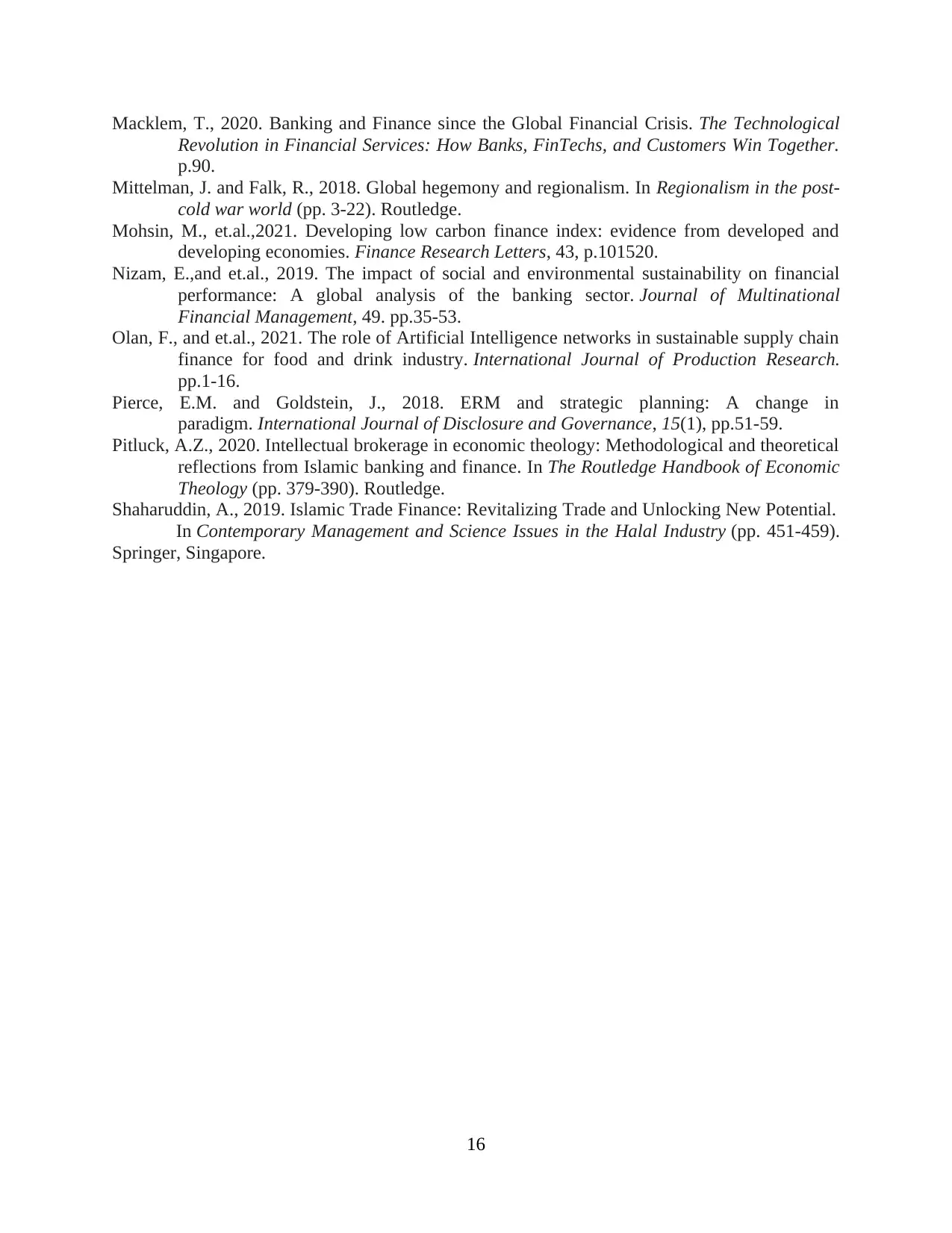
Macklem, T., 2020. Banking and Finance since the Global Financial Crisis. The Technological
Revolution in Financial Services: How Banks, FinTechs, and Customers Win Together.
p.90.
Mittelman, J. and Falk, R., 2018. Global hegemony and regionalism. In Regionalism in the post-
cold war world (pp. 3-22). Routledge.
Mohsin, M., et.al.,2021. Developing low carbon finance index: evidence from developed and
developing economies. Finance Research Letters, 43, p.101520.
Nizam, E.,and et.al., 2019. The impact of social and environmental sustainability on financial
performance: A global analysis of the banking sector. Journal of Multinational
Financial Management, 49. pp.35-53.
Olan, F., and et.al., 2021. The role of Artificial Intelligence networks in sustainable supply chain
finance for food and drink industry. International Journal of Production Research.
pp.1-16.
Pierce, E.M. and Goldstein, J., 2018. ERM and strategic planning: A change in
paradigm. International Journal of Disclosure and Governance, 15(1), pp.51-59.
Pitluck, A.Z., 2020. Intellectual brokerage in economic theology: Methodological and theoretical
reflections from Islamic banking and finance. In The Routledge Handbook of Economic
Theology (pp. 379-390). Routledge.
Shaharuddin, A., 2019. Islamic Trade Finance: Revitalizing Trade and Unlocking New Potential.
In Contemporary Management and Science Issues in the Halal Industry (pp. 451-459).
Springer, Singapore.
16
Revolution in Financial Services: How Banks, FinTechs, and Customers Win Together.
p.90.
Mittelman, J. and Falk, R., 2018. Global hegemony and regionalism. In Regionalism in the post-
cold war world (pp. 3-22). Routledge.
Mohsin, M., et.al.,2021. Developing low carbon finance index: evidence from developed and
developing economies. Finance Research Letters, 43, p.101520.
Nizam, E.,and et.al., 2019. The impact of social and environmental sustainability on financial
performance: A global analysis of the banking sector. Journal of Multinational
Financial Management, 49. pp.35-53.
Olan, F., and et.al., 2021. The role of Artificial Intelligence networks in sustainable supply chain
finance for food and drink industry. International Journal of Production Research.
pp.1-16.
Pierce, E.M. and Goldstein, J., 2018. ERM and strategic planning: A change in
paradigm. International Journal of Disclosure and Governance, 15(1), pp.51-59.
Pitluck, A.Z., 2020. Intellectual brokerage in economic theology: Methodological and theoretical
reflections from Islamic banking and finance. In The Routledge Handbook of Economic
Theology (pp. 379-390). Routledge.
Shaharuddin, A., 2019. Islamic Trade Finance: Revitalizing Trade and Unlocking New Potential.
In Contemporary Management and Science Issues in the Halal Industry (pp. 451-459).
Springer, Singapore.
16
1 out of 17
Related Documents
Your All-in-One AI-Powered Toolkit for Academic Success.
+13062052269
info@desklib.com
Available 24*7 on WhatsApp / Email
![[object Object]](/_next/static/media/star-bottom.7253800d.svg)
Unlock your academic potential
© 2024 | Zucol Services PVT LTD | All rights reserved.





